Introduction
The Château de La Napoule, the medieval fortress and fairy tale world of artist, Henry Clews, Jr., is located on a promontory, which overlooks the Côte D'Azur in Southern France. Clews purchased the Château in 1918, began restoring the architectural structure, and created a magical environment in which to produce his art. He continued to reside here somewhat removed from society until his death in 1937. This castle became a memorial to Clews in 1951 known as the Fondation d'Art de La Napoule established to facilitate the development of cultural relations between France and the United States. I first encountered the art works of Clews in 1991 during a one-week stay at the Château while on tour with the Nikolais and Murray Louis Dance Company of New York. Intrigued by my visit, I may testify to a fact best described in Clews' own words, "There is indeed a dangerous creative spirit loose in La Napoule."
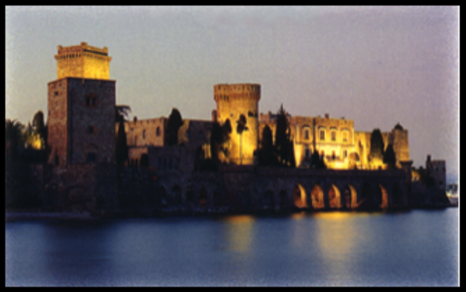
I observed firsthand the uncanny wisdom, talent, and dedication displayed in Clews' art. This supernatural inspiration sparked an ongoing period of research into his life and art. A first attempt to express these experiences occurred in my 1994 choreographic work; Henry's Own Words. Whistling Doves is a further exploration of my desire to express the connection I have found with Clews' art. This process began with a significant research element. Secondary research was conducted between 1991 and 1998. This period was followed by ten days of primary, on-site research and media collection as I returned to the Château de La Napoule in September of 1998.
Whistling Doves is a solo evening of multimedia dance theater. Through the presentation of this new work it is my hope that the American public may become more informed about Clews' art and intriguing lifestyle. Clews' personal experiences, sculptures, paintings, and writings support the development of character in the solo performer. The white dove, a favorite pet of Clews, is used throughout as a metaphor suggesting the spiritual transformation of Clews. This dual role provides a means by which the work may bring together elements of realism and abstraction.
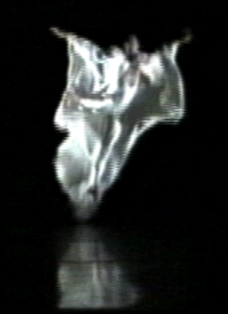
A white-box theater was constructed within the intimacy of Studio III in Sullivant Hall on The Ohio State University campus. This space acted as a three-dimensional projection studio, which made use of an entire wall of mirrors reflecting projected video images and creating multiple illusions of perspective. Technology played an important role in the manifestation of these effects. This new work may be seen as a further development of the use of technology in dance as seen in the previous works of Oskar Schlemmer and Alwin Nikolais. It contains a blending of spectacle and effect with cinematic conventions that result in what might be called "live cinema." The real-life subject matter, which has resulted in a work somewhat biographical in nature, is however, atypical of these influential artists. My previous works, like Whistling Doves, were greatly infused with an approach to modern dance performance typically associated with the German tradition as brought to America by Hanya Holm and further developed by Alwin Nikolais. Unlike this new work, they were much less dependent on technological elements.
Whistling Doves is divided into a number of small sections, which provide insight into a variety of experiences that Clews may have encountered throughout his life in La Napoule. Following the opening credits, a video collage which hints to the subject matter which is to be explored within the piece, are the following sections: Character, Chevalier, Bon Vivant, Slicelight, Painter, Castelan, Sculptor, Immortal, Sprite, and Élan Vital. As the ten somewhat chronological vignettes unfold, the audience witnesses a parallel development; the artistic growth, mortality, and immortality of Clews and the maturation of a young dove. The awkward and youthful chick gains wings and joins the flock as Clews develops artistically and attempts to find his place in society. As the piece resolves, the images merge in flight as Clews ascends into a state of spiritual after-life.
The title, Whistling Doves, is derived from a number of influences. A myth has crept into the annals of La Napoule that little silver flutes were attached, by Clews, to the wings of the doves that flew in his garden. Clews died in Lausanne in 1937 with a cage of his beloved white birds beside him. He was an old soul, one who has passed through many bodily forms and carried with him, in his subconscious, ancient memories and a remarkable knowledge of life (Clews, Once 86). He may have even known that his present life was only a further chapter of the great book of his spiritual evolution. Clews' tomb is located at the base of the west tower of the castle. This tower contains a sealed room high above the sea that is only accessible through two small windows, a private space where spirits may exist for eternity. On the wall of the tomb inscribed in stone you will find Clews' poem.
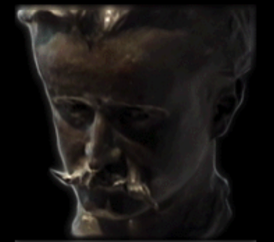
If God grant me three score and ten
I shall be ready to depart.
I shall have finished with my art
And with the ways and wiles of men.
I hope, however, to return
But not as Ouija spook before
Pures, spiritists, of Marxist or
Scientific feminist - I yearn
To come at eventide as sprite
And dance upon the window sill
Of little folk, wide-eyed and still
When summer moon is shining bright.
And I shall dance with might and main
To let dear little children see
How quaint and funny I can be.
From science I shall set them free
And give them mirth and mystery
And myth and fairy lore again.
Henry Clews, Jr.
The writings, which follow, provide detailed descriptions of the process that resulted in the creation of Whistling Doves. These include: research and media collection; constantly evolving conceptualization and planning; and production. The final chapter reflects my current beliefs on the creation of dance in the field of multimedia. An analysis and critical evaluation of my process in creating Whistling Doves, and the product itself, are presented in relation to this evolving manifesto. The extensive nature of the appendices reflects the magnitude of this project, one inspired by a force that continues to motivate my creative endeavors.
Chapter 1: Research and Media Collection
The research and media collection for Whistling Doves began in 1991 with my initial introduction to the art of Clews. As I left the Château de La Napoule on August 16, 1991 I carried with me a tour journal, which contained many samples of text and memories, which would inspire the creation of dance works for years to come. Direct exposure to the work of Clews, as displayed in the natural setting of his home, lead to this early preliminary research. My journal contained sketches of various symbols created by Clews, a poem that I wrote during my visit, and a hastily written copy of a poem by Clews, which I encountered engraved in his tomb during the final hours of my stay.
Passages from Clews' personal library were copied into this journal, including excerpts from Our Life After Death by Arthur Chambers and The Evolution of the Soul by Thomas Jay Hudson. The bookmarks left behind in these texts seem to hint to Clews' beliefs of reincarnation and the existence of an after-life. These ideas were to become primary themes in Whistling Doves. Copies of these books were later obtained for closer examination through interlibrary loan.
Several postcards were purchased from the Château gift shop providing the first substantial graphics in my collection. Not realizing the impact of this original visit I failed to gather photos and video by which this experience might be illustrated. Murray Louis purchased a picture book on Clews, which I borrowed shortly after leaving La Napoule. The focus of this book was the sculpture of Clews and provided very little information on his personal life, an area that I found to be very intriguing.
Following this experience in France, library and Internet searches in Madison, Wisconsin led to very little information on Clews. The book, Henry Clews, Jr., Sculptor, by Beatrice Proske was the first significant find at the Elvehjem Art Library at the University of Wisconsin-Madison. This book provided detailed descriptions of many of Clews' works with only sparse details on his family and personal life. From this information I was able to develop the skeleton of the Clews' family tree. Realizing that in-depth research on Clews would be difficult in the United States, I temporarily put aside this project after creating a group dance in 1994 entitled Henry's Own Words.
With the introduction to additional research methods in the Resources Seminar course taught by Associate Professor Angelika Gerbes at The Ohio State University in the autumn of 1996, I developed a mock research proposal based on Clews. At the time I did not realize this would become the subject of my MFA Thesis/Project. I was encouraged by the amount of information available through OhioLink and newly developed websites. G. A. Shattergood-Moore mastered a website on Clews that contained links to Brookgreen Gardens, SC where two of Clews' sculptures were on display. Several newly discovered books on Clews and the Fondation d'Art de La Napoule were requested through interlibrary loan. The most exciting text was Clews' only publication, Mumbo Jumbo, published in 1923. This was a satirical play centered on the artistic development and critical acclaim of a young artist. It seems at times to provide autobiographical reference. Thanks to MFA committee member, Associate Professor John Giffin, and to the publishers who have made their books available on-line, I would soon have my own copies of Mumbo Jumbo and Proske's Henry Clews, Jr., Sculptor. Several newspaper articles were found through searches in the periodical index including social events related to Clews. Acquiring many such articles required a visit to the library at Ohio University in Athens. Resource materials seemed to be flowing in from all directions. Eight, three-ring binders and a filing system were required for the volumes of information.
During these early stages black and white images from the books acquired and the postcards from the Château were scanned in preparation for becoming visual support within the project. Little did I know, this was only the beginning and that these resources would seem meaningless in number compared to the media and information which would follow.
The selection of music during these early stages was based on several master images, which I hoped to include in the work. Romance, chivalry, and grandeur often came to mind when thinking of the atmosphere within the medieval castle. A selection from Eugene Friesen's New Friend compact disk captured this feeling and had previously been used in the 1994 work, Henry's Own Words. I hoped to expand upon the content explored in this piece and felt that other selections from this compact disk would provide musical cohesion within the work.
A variety of chanting sounds were considered in hopes of suggesting the spiritual existence of Clews and the gothic feel of his tomb located in the tower of the castle. The group, Anonymous 4, was suggested but discarded early in the process, as the quartet of women's voices seemed to relay a confusing message. A search for male chanting voices lead me to a compact disk called Mystical Chants and to works by the group Chanticleer. Many works by Chanticleer captured the desired mood yet seemed to be suggestive of Catholicism. The chance discovery of the compact disk, Athos, by another of my favorite composers, Stephan Micus, provided what seemed to be the ideal compliment to the modern/classical scores by Friesen.
Other musical considerations included the use of period music, both French and English lyrics, which might represent the time in which Clews lived in the Château in France (1918–1937). A series of French compact disks were discovered which were categorized by decade as well as others more specifically dated by year. After purchasing and listening to these compact disks for months, I narrowed the search to works performed by Edith Piaf, Maurice Chevalier, Lucienne Boyer, and Damia.
A favorite love song, Parlez-Moi D'Amour (Talk to Me of Love), seemed to capture the somber isolation Clews must have experienced in his private world in La Napoule. A symphonic version of this melody became the sound track for the Bon Vivant section, which suggested an elaborate social gathering hosted by Clews, one in which he set himself aside from society.
Piano Concerto No. 2: Andante by Dmitri Shostakovich became the exception to any sense of musical cohesion, except in the romantic sense. Composed after Clews' death in 1937, this selection was intended to provide a timeless escape into the inner thoughts and emotional state of Clews suggesting that his spirit may continue to exist beyond his physical presence.
Ambient sounds were layered throughout the sound score to establish mood, place, and atmosphere. Ocean sounds dominated the Slicelight section accompanied by the Shostakovich score. Dove sounds recorded from live doves and captured from a National Audubon Society's VideoGuide to Birds of North America were used at key moments reinforcing the dove metaphor.
Vocal text became a layer within the sound tracks for the Character, Slicelight, and Immortal sections. These passages of text were taken from various sources including my poem, Clews' poem, and the 1920 poem, To Henry Clews on His Home-coming, by Louise Morgan Sill. Clews' 1923 character description of John Brown in his book, Mumbo Jumbo, became the primary text for establishing the role of Clews as an emerging artist in the first solo, Character.
As twilight shimmers and plays through a grove of spring leaves, so do expressions of sweet melancholy, gentle bewilderment and mild apprehension hover and flit over his hyper-sensitized, ascetic face, which never blooms into merriment, although it is occasionally brightened by a faint, delicate smile of affectionate sympathy.
At times his pale face appears to be illuminated by an almost supernatural light...as if it were, an aureole about his head. He has been overshadowed from childhood by the ugly, sordid spirit of your times. He is Art, weakened, corrupted, diseased, degenerated and driven mad by democracy, science and power-machinery.
The collection of sounds and video expanded to involve the purchase of two white doves. These pets were to become subjects for the study of movement vocabulary, sounds to be layered with musical selections, photographs for publicity and graphic imaging, and video to be projected within the performance. From the beginning, it was also my intention to find a way of including the live doves in the production. Little did I know that by opening night they would have multiplied, resulting in a display of six doves.
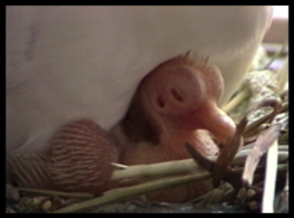
A major turning point in my research process occurred on July 13, 1998 when I received a telephone call from a most pleasant and supportive caller, Margaret S. Clews. Ms. Clews is the daughter-in-law of Henry Clews, Jr. She, along with her husband, Mancha Madison Clews, is quite influential in the operations of the Fondation d'Art de La Napoule. Her call resulted from a series of events that began with the on-line discovery in April of 1998 that she and Mr. Clews had published Once Upon A Time At La Napoule: The Memoirs of Marie Clews. Marie Clews was the wife of Henry Clews, Jr. I had ordered this book immediately after reading about it on the Barnes and Noble website. After weeks of waiting I received word that the book was unavailable from the publisher. I requested information on the publisher, went directly to them, and expressed my extreme desire to purchase the text. The publisher, Memoirs Unlimited, passed this message on to Ms. Clews who returned my call without knowing of my interest in the Clews' family.
Ms. Clews and I conducted a forty-five minute telephone conversation in which we exchanged information on the history of her family and the subject matter of my research. At the time of the call I was unable to locate a piece of paper on which to keep notes, so I grabbed the only thing I could find on which to write. At the end of our conversation I had filled the front and back of a brown paper bag with new and exciting information. It was during this call that Ms. Clews notified me that a private family collection of Clews' sculpture was on display through the end of the week at the Newport Art Museum in Newport, Rhode Island. She invited me to the museum on the following day to document the collection for my research, a day in which the museum would be closed to the public. Our conversation was followed by a quick call to Judith Sobol, director of the Newport Art Museum, to discuss copyright issues and two hours later I departed Columbus for a cross-country road trip to the childhood home of Henry Clews, Jr.
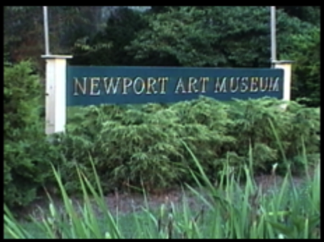
The following two days were spent photographing and videotaping the works of Clews with permission from Ms. Clews. I was also allowed access to the private family scrapbooks that contained photos and letters, many dating from as early as 1918. It was here that I was able to purchase a copy of Ms. Clews' book, which became, by far, the most complete reference on Henry Clews' life. My brief visit to Newport, Rhode Island made a significant contribution to the collection of media and information on Clews. These few days at the Newport Art Museum represented the first primary research authorized by the Clews family. This limited access to resources provided an exercise in efficiency and thoroughness, which better prepared me for later efforts in France. While in Rhode Island I also gained a better understanding of what Clews childhood must have been like among the mansions of Newport. Research at the Newport Historical Society and the Redwood Library of Newport provided information on the childhood residence of Clews called "The Rocks". Although the structure has since been demolished, I was able to visit the location of the home and video taped the ocean outside this landmark. This footage along the Atlantic Coast would later be merged with video taken on the shores of the Mediterranean blurring the boundaries between time and space within Clews' life.
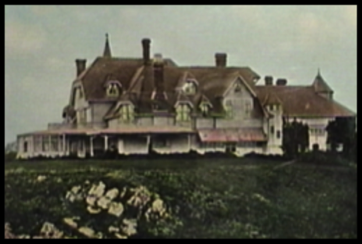
Only days after returning from Rhode Island a five-day residency was scheduled which brought John Meyer, multimedia/video/dance documentation/design/arts administration specialist and personal friend, to Columbus from Madison, Wisconsin to assist in the process of video taping movement material. Meyer and I completed BS degrees in InterArts and Technology from the University of Wisconsin-Madison in the mid 1990's and felt that our common background in media arts would provide an excellent foundation for collaboration. Meyer had documented my company concerts in the past and I was confident that he would make contributions in the areas of video and multimedia production, which would greatly benefit the project. This video residency was an essential aspect of producing Whistling Doves. This collaborative work addressed the only obstacle I found unable to conquer alone, the ability to operate the camera as I danced before it. Meyer's expertise contributed greatly, both technically and artistically. Over thirty hours were dedicated to the shooting of video during his five-day visit. The Sullivant Hall Theater was utilized as a black space and Studio III was prepared to appear as it would in January. Aside from the studio work, Meyer and I exchanged personal experience on the use of Adobe Premiere. Meyer's visit was funded in part by a Vera Blaine Special Projects Grant obtained through The Ohio State University Department of Dance.
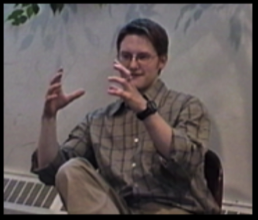
During the month of September 1998, after months of correspondence with Patricia Corbett, Director General of the Fondation d'Art de La Napoule, I was invited to the home of Clews for a week of on-site research and media collection. Equipped with a Pentax 33mm camera and a Sony Hi-8 video camera I would arrive at the Château prepared to act as photographer, videographer, and performer.
On my way through New York I was given the option to forfeit my seat to Paris and take a flight on the following evening. I agreed and spent September 2nd in New York City. I was fortunate to find Murray Louis at his studio and was able to conduct a brief interview regarding his former visits to the Château. Louis remembered my 1991 fascination with the life and art of Clews and was able to comment on both his knowledge of Clews and his recollection of my original experience that I had communicated to him eight years earlier in La Napoule.
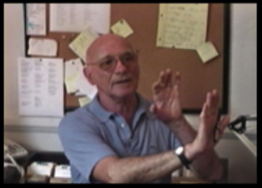
I left for Paris that evening rejuvenated by the reminiscent conversation with Louis.
The timing of my trip was excellent as Corbett was attending a conference in Paris for the week. The Assistant Director, Nelcy Fourriques, gave me extreme freedom and support. There were no guests staying in the castle at the time and only a few one-hour tours given in the afternoons. I found great pleasure in attending these tours and at times was able to provide supporting information and English translations for the tour guide. An average of nine to twelve hours per day, for seven days, were spent documenting the Château and the works of Clews.
Areas of the Château were sectioned off allowing for specific focuses within my research. These areas of interest included the garden, the studio of Clews, the main room, the tomb of Clews, the archways along the sea, and the west tower. Each area would be fully explored with the 35mm camera and the video camera, both capturing images that would hopefully find their way into the final production. Later each area would become the background for movement in various costumes. I would leave La Napoule with three hundred and twelve slides and sixteen hours of video footage.
One afternoon was spent interviewing Fourriques and exchanging research information. I brought with me a suitcase filled with articles and notes collected in the United States, which I gladly provided for duplication. In exchange for this collection I was allowed to make copies of the scrapbooks kept on file in the Fondation office. It gave me pleasure to know that I had made a contribution to the documentation of Clews work. During this interview Fourriques spoke of several unusual events that had occurred at the Château.
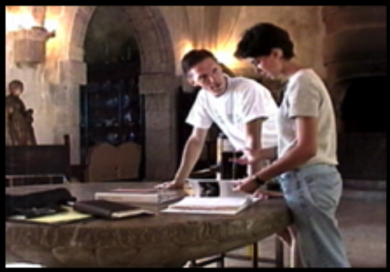
Near the end of my visit I was astonished to discover a pair of white doves perched atop one of the tall pine trees in the garden of the Château. As I panned the camera across the skyline of the castle and began to zoom in to the pair of doves perfectly illuminated by a beam of sunlight, I knew I had been provided with an establishing shot which would link the location of my work to the metaphor of Whistling Doves.
With an extensive collection of text, sound, video, and slides my task would now become limiting and structuring ideas into a form that could be achieved within the time frame of my degree program. It is important to note that the conceptualization and planning of Whistling Doves was largely influenced by the collection of media throughout this process.
Chapter 2: Conceptualization and Planning - Content and Technical Issues
The moments of primary research conducted in France became the pinnacle of media collection that had a wide-ranging impact on the conceptualization of Whistling Doves. Because of this, the conceptualization and planning involved in creating this work may be divided into three chronological phases; Pre-France, France, and Post-France. Technical considerations and the acquiring of additional media constantly influenced choices made regarding content within each phase. This unique process was far from one of conception followed by realization. Preconceived ideas necessitated the acquiring of specific content while the constant discovery of media elements brought to the forefront numerous conceptual possibilities. The excitement of my process was characterized by these ever-changing influences, such as media discovery, and a mixture of increased technical competence and technical limitation. Media artist and collaborator, John T. Meyer, who assisted the process in late July of 1998, acknowledged this aspect of working in the field of multimedia.
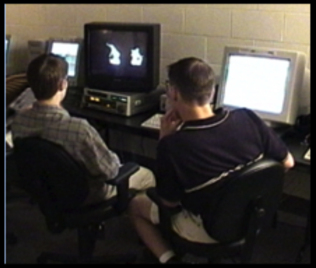
This necessity to "listen" to the suggestions made through content development and technical discovery kept the final vision of the developing work just beyond an ever-receding horizon.
The process of creating a new work such as this brings to the foreground many decisions and concerns which are crucial in developing ones own personal approach to the application of technology and the creative process in general. This specific process involved an immense vision that required a great deal of planning. Hope and trust became constants throughout the process as I envisioned the many elements involved coming together to find a sense of unity in the end.
Early stages of planning involved the development of timelines used to organize and project the progress of the work. Knowing that the elements of technology involved in Whistling Doves would require a great deal of time; it became extremely important to begin the process early. It was equally important to allow for recreating or redesigning due to creative discovery or technical flaw. The original timeline was frequently modified, and resulted in the following general schedule of events.
Initial inspiration - Summer 1991
Preliminary research (Secondary Research) - Summer 1991–Winter 1999
Media Collection/Project Design/Experimentation - Autumn 1997–Winter 1999
John Meyer Video Residency - July 22–27, 1998
Research Travel (Primary Research) - Summer and Autumn 1998
Newport, RI - July 14–16, 1998
(Newport Art Museum, Redwood Library, Newport Historical Society)
La Napoule, France - September 2–10, 1998
(Château de la Napoule - Foundation Henry Clews)
Production Period - Summer 1998–Winter 1999
Project Premiere - Winter 1999
Post-Production/Documentation - Winter–Spring 1999
The conceptualization of Whistling Doves prior to re-visiting La Napoule in 1998 was based on the media collected at that point as well as the projected media that I hoped to obtain during a visit to the home of Clews. From the beginning I knew the work was to be based on a combination of influences drawing from the art works by Clews, Clews' personal experience as an artist, and my own response to each. I felt that these influences could be merged and crafted in a manner, which would result in an abstract fairy-tale grounded in real-life experience.
Folding the inspirations for this work into an evening of multimedia dance theater was influenced directly by my basic beliefs on producing work which may be found intriguing to an audience. I realized the need to channel an extremely personal experience with Clews into a more universal message that would allow for a broader audience response. The use of variety and contrast in visual design, musical selection, and movement vocabulary was a primary concern in my effort to capture the interest of those who were to experience the work. This awareness assisted in the sequencing and development of the various sections, which ultimately were linked to form the one work.
Studio III was chosen as the performance space for Whistling Doves. The space, typically converted into a black box space, was transformed into a completely white space with the use of projection screens, curtains, and a white vinyl floor covering. This created a three-dimensional canvas for projection. This intimate space accommodated around seventy-five audience members who, seated on the diagonal, were given the option of witnessing the performance in mirror reflection. Because of this configuration many design choices were influenced by the audience's optional line of vision. This design choice disrupted the choreographer's traditional understanding of the use of stage space. Front became diagonal, center stage became far stage left, and symmetry was inevitable.
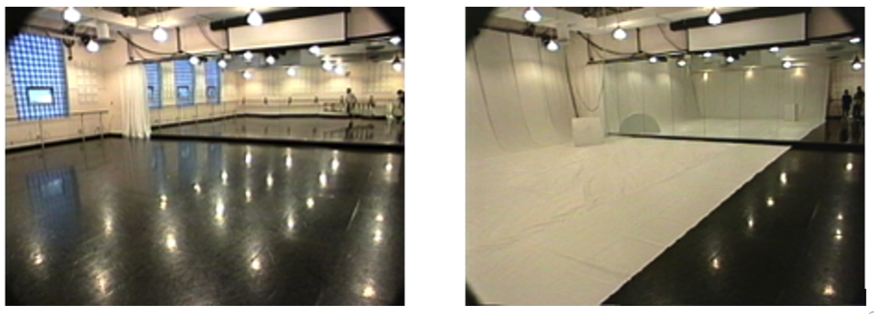
The manipulation of the space through the use of curtains, a moving screen, and a changing set consisting of two large geometric props became an issue in the design process. An entire wall of mirrors was concealed behind large white curtains. When opened, the space could be doubled in size due to the reflection of the room in the mirror. Balance within the space was transfigured by relocating set pieces, opening and closing the curtains, and repositioning the automated projection screen. This also altered the surfaces that could be projected onto in the performance space and influenced the length of projection, as the mirrors were often used as a means of bouncing projected video throughout the space. Illusions of infinite spaces were created through the re-projection of video shot within the white-box space. By projecting a video image of the performance space on the walls of the space, it appeared that all three walls were producing mirror reflections. The planning of these shots, assisted by technology, allowed for a wide range of spatial designs and illusions.
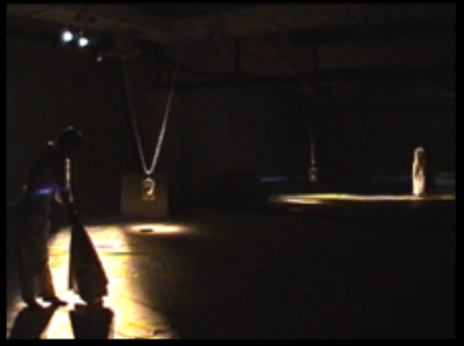
The inclusion of contrasting musical scores was a conscious decision. Heavily inspired by the music of Friesen and Micus, I felt that their effect might be enhanced when heard in direct relation to other styles of music. The Painter section, set to the French lyrics from Du Soleil Dans Ses Yeux, provided a light and comical feeling not seen in other sections of the work. Visualizing this section with the use of an over-sized paintbrush with palette and a follow spot, magnified the uniqueness of this animated section. To maximize this contrast, Painter was programmed to follow the dark, lonely soliloquy of the Slicelight section. The layering of text in several sections provided another means of manipulating aural elements.
The concept for Whistling Doves included a variety of groupings suggesting solos, duets, trios, and group sections. These were all made possible through the use of technology. At times I hoped to interact with shadows, at times with projected video of myself dancing, as well as with numerous dancing figures, dove imagery, and architectural spaces. The staging and placement of movement within the space was conceived section by section based on the influences of technological elements including projected video and the limitations of theatrical lighting within the space. As the process began to develop I realized that every decision in every area required taking into consideration the multiple influences of all production elements. These considerations greatly influenced the movement aspect of the production. The concern for variety in movement content may be compared to the attention given to variety and contrast in the use of spatial arrangement and musical selection. The range of movement vocabulary included inspirations from a list of descriptive words associated with my vision of various moments within Clews' life. This list included qualifiers such as: chivalric, noble, lonely, withdrawn, clever, comic, mysterious, witty, spiritual, bourgeois, elite, eternal, youthful, weary, curious, tranquil, desolate, majestic, stately, and ecstatic.
Issues of time were of great concern in the decision making process. A variety of periods would be interwoven throughout Whistling Doves. The architectural surroundings for much of the work were taken from images of the medieval castle of La Napoule. Clews lived in this castle only from 1918–1937, yet is entombed there for eternity. Architectural elements of the white space in Studio III were often blended with the castle-like atmosphere. This alluded to time in the present. Music was selected to support and enhance all the above.
Prior to confirming the research abroad portion of this project I began a search for local spaces that might provide alternate atmospheres for media creation. This back-up plan relied on the ability to suggest location through clever editing. I knew that a sense of moving within the Château de La Napoule could be created through the use of an establishing shot of the castle followed by closely cropped footage against similar backgrounds. Several spaces were considered including a stone, out-door theater along the banks of the Olentangy River, the stone tower of a church located in Columbus' Victorian Village, and at Squires Castle near Cleveland, Ohio. Video footage and photographs were collected from these areas for early experiments and conceptualization.

Whistling Doves provided a means for conquering personal challenges. I purposefully imposed limitations on the process to ensure the investigation of new areas of art creation. Prior to Whistling Doves, the majority of my dance work had been for large groups. I adventurously committed to an evening of solo work. On numerous occasions I resisted the temptation to expand the cast. A group revival of Henry's Own Words, a male duet, and a female role to represent Clews' wife were all considered. The ability to easily tour this work along with the desire to maintain freedom in the scheduling of rehearsals contributed to the decision to remain a one-man-show. This also seemed appropriate, as Clews had worked much of his life in isolation within his studio.
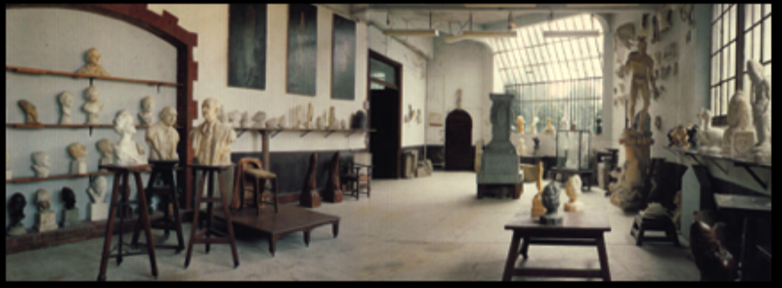
Clews' artistic development grew from his early work as a painter to a more developed and mature profession as a sculptor. Anticipating these periods of his life as separate developments supported by actual images of his work, and knowing that a final image within the piece would be his spiritual transformation, it seemed logical to position the sections of the work in a chronological order. The following is a comparison to the sections of Whistling Doves as they appeared in the original draft created in June of 1998 and the final version of December 1998.
June
Opening Credits
Solo (untitled)
———
Riviera
Slicelight
Painter
Henry's Own Words
Sculptor
Procession and Ascension
Feathers
Infinity
Opening Credits
Character
Chevalier (added after France)
Bon Vivant (formerly Riviera)
Slicelight
Painter
Castelan (late decision to replace Henry's Own Words)
Sculptor
Immortal (formerly Procession and Ascension)
Sprite (formerly Feathers)
Élan Vital (formerly Infinity)
Although the overall vision of Whistling Doves was fairly clear early in the process, the detail of form and content varied in completeness from section to section. With media collected from early research, the John Meyer video residency, and the visit to the Newport Art Museum it became possible to complete four sections of Whistling Doves before traveling to France. These sections were conceived prior to Meyer's arrival in Columbus suggesting specific goals for our work in video production. By this point in the process several images had materialized. I felt a strong inspiration to include representations of Clews' spiritual presence, which I had felt in the castle. These images included his personal investment and relationship to the sculptures he created, the sense of his spirit ascending from his tomb into the private space above, and the omnipresent moon, which appeared in the poetry related to Clews. All these aspects of the artist's life would be interwoven with a parallel development of dove imagery. The producing of these images required that all video material be planned in advance taking into consideration the intended effect of each image and the process of technical application. Since much of the projected video created during the Meyer residency was to be seen in direct interaction with the live performance which would occur months later, it became necessary to construct all costumes, props, and sets very early in the process.

The Sprite section was one of the first sections to be completed. In my mind, this section represented the merging of Clews' spiritual contentment after death with the freedom of flight experienced by the dove. I hoped to position this experience inside what I envision to be the private space that exists in the top of the tower above Clews' tomb. This space, designed by Clews, may only be accessed through two small windows near the top of the tower. Created as a haven for spiritual eternity, I attempted to allow the audience insight into this space as they witnessed Clews' transformation into flight. The use of existing architectural elements within the projected video, such as the windows from Studio III, helped blur the distinctions between Clew's atmosphere in France and the present surroundings within the performance space. I hoped to literally place the white space within Studio III inside the top of the medieval castle in France.
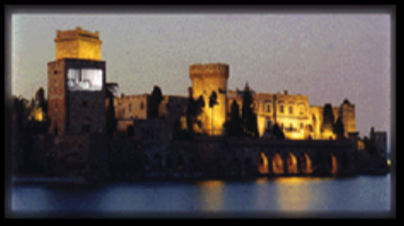
The movement within this section relied heavily on the projection of numerous dance phrases that were superimposed to create the illusion of a large group work, a collage of spirits in celebration, or a flock of doves. As performer of all the elements that made up these group sections, I found it necessary to envision the vocabulary and spatial relationships of the other virtual dancers as I danced each phrase alone in the space. The overall goal of this section was so clear in my mind that group interaction seemed to be experienced as the phrases were captured one-by-one on video. This experience was magnified during moments of entry onto the stage when I had to stand in the wings, envision the choreography of the other roles, and enter at the correct moment and location that could be convincingly superimposed to suggest that all the phrases were happening simultaneously.

The Élan Vital section involved a design that contained similar aspects of architectural elements and life-size movement projections. This section was divided into two primary ideas. The first idea contained the projection of excerpts from solos previously seen in earlier sections. These solos were revealed by the rising and descending movements of the automated projection screen in the performance space. The illusion was created that there were six automated screens, when in reality there was only one, by video taping these excerpts and projecting them at various locations around the room. This section acted as a series of flashbacks, which recalled various moments within the life of Clews. The second idea within the Élan Vital section evolved over time taking many different forms. I hoped to create a video effect that would be indistinguishable by the audience from live performance. The original idea was to have a live silhouette move through a series of lights while having the same image projected on the other screen. The virtual image and the live silhouette would merge at the focal point in the space. It was later determined that there would not be enough space to position the lights behind the screen and both images would be projected from the front. A picture of an archway from the castle was manipulated in Adobe Photoshop and layered with the video image of the moving shadow to create the illusion of a spirit lurking beneath the archways of the castle.
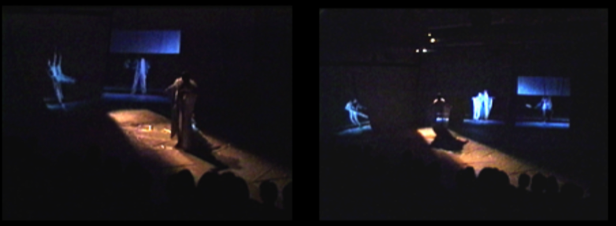
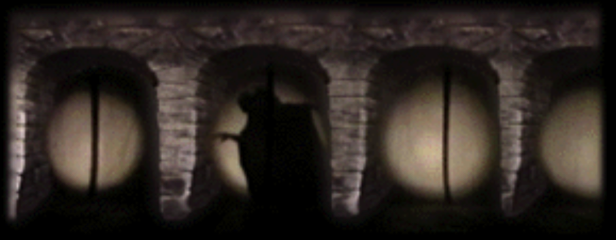
The Sculptor section also required specific video capture based on a choreographic concept. The primary subject matter addressed in this section dealt with Clews' more refined work as a sculptor. In the same section I wanted to recall his experience working in this field and bring to life one or more of his sculptures. Clews' The God of Humormystics and The Thinker became two of the main images used in this section. I found The God of Humormystics sculpture to be of particular interest based on its history as commented on by Fourriques.
The inspiration for Clews' The Thinker provided a natural progression into immortality as the work was based on an individual who had had all the life drained from him through his struggle to attain enlightenment. In my work a large cube would be used as the base of these sculptures and would have the intricately designed base of The God of Humormystics projected onto it. I would allude to the sculptures coming to life by dissolving from still images of the sculptures into video footage of myself improvising with movement from the shape of the sculptures. The angle of projection for these images became crucial as the images were intended to appear just above the projection on the base. The live movement from this section alternated between the roles of the sculptor and the sculpture. Smoothly rotating images of the dancing sculptures were created on the black background of the Sullivant Hall Theatre stage with the use of a swivel chair. At times I moved onto the sculpture base and interacted with other images of myself being projected below. Within this section I explored numerous combinations of being the art and the artist as well as the live and the virtual performer.
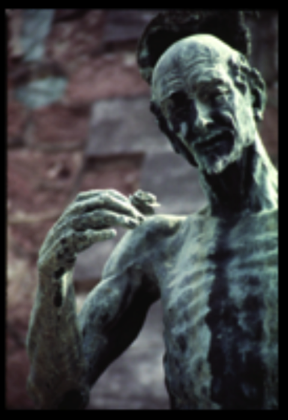
The Sculptor section was followed by Immortal. A simple spatial pathway, which I associated with the burial ritual and spiritual ascension of Clews characterized the early images of this section. I have found only small bits of information on the burial of Clews in the tower but see this ritual as having a horizontal element, the transportation of Clews' body across land to the tower, and a vertical element, the rising of Clews' spirit from the tomb into the top of the tower. This progression provided the spatial motivation for this entire section. The original idea for movement throughout this section was to be a minimal, low-level travel across the edge of the white space near the audience. The method of travel was originally to be made possible by a rope attached to a pulley system mounted very close to the floor. This mechanical element would be eliminated and the entire movement idea would be modified later in the process.
Many of Clews' sculptures were carved in stone and represented the personalities of his acquaintances. Images of these sculptures, when seen against a background of chants by Micus created an eerie mood which, for me, made the sculptures seem to act as gravestones. Many of these sculptures were animated creating a moving background of landmarks from Clews' life. Images of candlesticks taken from photos inside the castle were used to create atmosphere. The flame of a candle was videotaped inside the Department of Dance Computer Lab and superimposed above each candle. This process made it possible to re-light a candle which may have been dark for over sixty years.
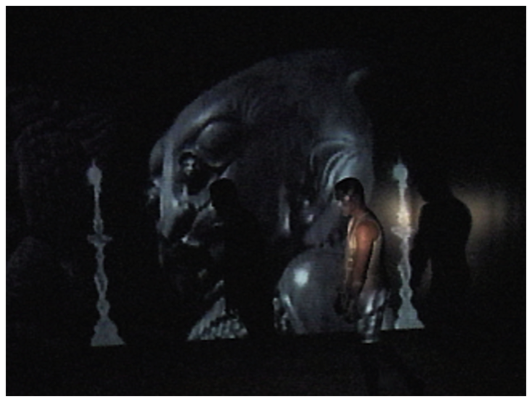
The middle section of Immortal made use of images taken from the private family scrapbooks accessed at the Newport Art Museum. A series of photographs taken of Clews at various moments during his life traveled across the space to provide a collage of memories. Popular music of the 1920's and 1930's faded in and out against a score by Friesen. The final image of this section was one that would attempt to create the sensation of being inside an elevator which would transport the performance space and the audience vertically to the top of the tower. Projecting an image of movement up the side of a large picture of the tower and zooming into the small windows at the top created this effect. This upward movement was emphasized as the burial robe costume ascended off the floor attached by fishing line to the rising, automated projection screen.
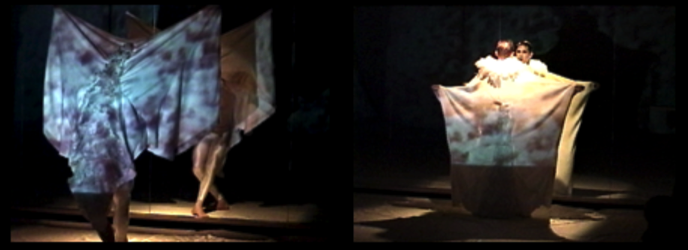
One other image in the Immortal section relied greatly on the use of technology. A composite image of Clews standing in the doorway of an infinite hallway of arches was created through still image processing in Adobe Photoshop. The actual doorway exists along the side of the Olentangy River in Columbus. The image of Clews' body was taken from an old family photograph from an early age. Clews' face was taken from an image taken shortly before his death in 1937, and the birdcage containing my pet dove, Myth, was taken from a frame of video shot by Meyer in July of 1998. Together these images resulted in a picture of Clews, which never really existed. An image of myself in the same position holding the birdcage dissolved over this picture and implied that Clews has transformed into a living image, which walks away down the tunnel of infinity.
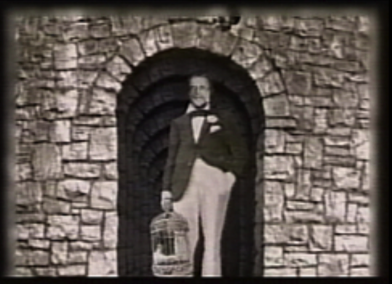
It was decided early in the process that there would be a cinematic introduction for Whistling Doves, which would act as the opening credits. I hoped to use this brief opening to introduce some of the imagery and provide hints to the subject matter to be investigated within the body of the work. My early visions of this section included an abstract tour through the architectural details within the Château. A selection of music by Micus was chosen and a plan to slowly reveal the setting of the work was designed in coordination with the music. I hoped to establish the climax of this opening by zooming out a window to reveal the first image of the entire castle as the title, Whistling Doves, appeared. This was to be followed with movement away from the castle and across the ocean. I knew this would be a difficult image to capture. The details of this section would be slightly altered once in France.
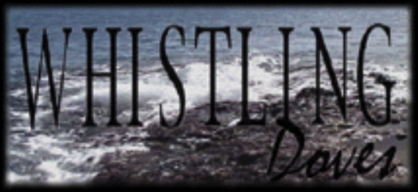
After years of research on Clews and months of planning for Whistling Doves I humorously found myself the victim of Clews' trickery and illusion. As I left Newport, Rhode Island on my way back to Columbus I began reading the introduction to Once Upon a Time at La Napoule: The Memoirs of Marie Clews written by Clews' son, Mancha Madison Clews. I was astonished to read, "And let me put to rest one myth that has crept into the annals of La Napoule: little silver flutes were most definitely not attached to the wings of pigeons to make a whistling sound!" Later when explaining the title of my project to Mancha Madison and Margaret Clews, Ms. Clews offered the response, "On the subject of the name, Whistling Doves, I think you are totally justified in using that title. Doves have long been a symbol of love and peace and are certainly part of the Clews legend."
Experimenting with simple animation techniques within the Adobe Premiere software program led to the early development of images which would become part of the Bon Vivant, Immortal, and Élan Vital sections. These techniques would later be revisited to manipulate media collected from Rhode Island and France. Scanned images could be imported into Adobe Premiere, given coordinates within a timeline, designed and choreographed within the space of the monitor, and exported to videotape. This process was used to animate images from the family scrapbooks of Clews which appeared in Bon Vivant, a series of Tom Tierney paper dolls which became the members of the Riviera Society in the same section, the doors of Castelan, and the images of Clews' sculpture and personal photographs featured in Immortal.
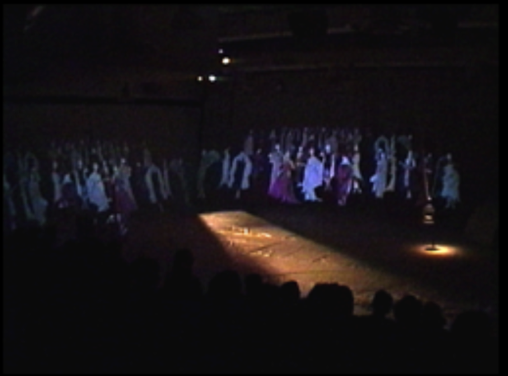
The Macromedia Director 5.0 software program provided even more animation-related options. While shopping in a card shop I discovered a postcard that contained three graphic images of a dove in flight. The first image illustrated the dove wings in the down position, the second in middle level, and the third in the up position. By scanning these images and programming them within the Director software, I was able to produce the animation of a dove in flight. Once created, this sequence could easily be duplicated and in a matter of minutes I found myself in command of a flock of white doves. I had spent a great deal of time searching for video footage of doves in flight and attempted to shoot the footage myself. With this discovery I was not only able to control the size and number of doves, I could also design their spatial pathways in time. This technique would result in the final image seen in Whistling Doves, an infinite flock of doves descending from the west tower of the Château.
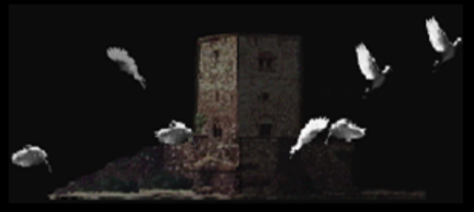
The technical concerns prior to my visit to France were centered on devising a methodology and series of guidelines from which all sections of Whistling Doves would be designed. Once these parameters where established I knew that I would have to commit to their use for the remainder of the project. Major decisions during this phase of planning included the positioning of projectors, the location of screens and props, the dimensions of the projected video, the source of video and sound, and the process of backing up media and the segments which were to be combined in the final work.
The placement of two, 300 lumen Sharp projectors required numerous evenings of testing and experimentation. The elevation, zoom, tilt, and angle of each projector became important in consistently recreating the desired effects. Once in position, a computer was connected to each projector to assist in mapping specific areas in the performance space. Since the walls of the performance space were wider than tall, the projected image had to be designated as only covering a portion of what would normally be a full-screen image. Screen shots of the computer's projected desktop were taken to map the specific location of props within the space, the automated projection screen, and the boundaries of each wall. Once identified within the projected canvas, each graphic was transformed into a matte that could be imported into the video-editing program, Adobe Premiere. These mattes were used in combination with transparency settings to assist in the positioning of graphics and video that would appear projected onto specified areas within the space. One aspect of the projected video that became important to remember was that the side projector would cast projections onto the automated screen when in the down position, yet when the screen was in the up position the projected image would bounce off the mirror and onto the opposite wall. This reflecting process horizontally flipped the video image. Therefore, whenever an image was intended to bounce off the mirror and hit the side wall, the video had to be created as the mirror image of what was actually desired.
Backing up all elements used to create the various sections of the work became an important and expensive part of my process. The video station for editing full-screen video in the Department of Dance Computer Lab includes a nine gigabyte external hard drive but can only manage about six to eight minutes of full-screen video at one time. Using a total of seven, eighty-five dollar, JAZ cartridges which each hold one gigabyte, I was able to transport small source clips to the Emerging Technologies Studio in Hopkins Hall where CD-ROMs were created for storing essential media. This process of "media juggling" became a very time consuming yet necessary aspect of the project. If at any point a previously produced section of the work had to be re-created this process would allow for the quick recovery of media.
By this point in the process a website containing information on the project was developed which contained still images taken from video. This website was used to document my progress and to promote the work for the anticipated premiere in January of 1999. Samples of the work in progress were taken from the sections completed as of July 1998 to produce a preview video that would be taken to France and shared with the staff of the Fondation d'Art de La Napoule.
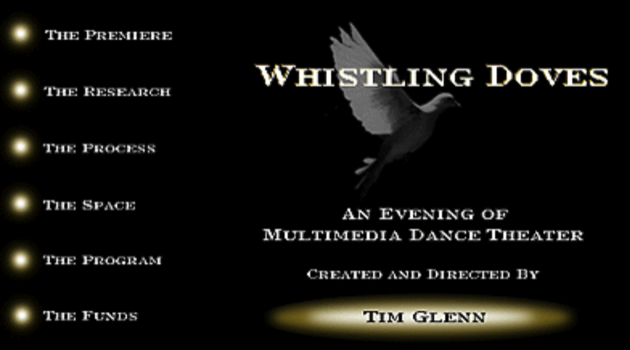
The ability to have direct access to the home of Clews, a space so plentifully filled with examples of his life as an artist, had an immense impact on the conceptualization and planning of Whistling Doves. Specific ideas for media collection were anticipated based on my vivid memory of the space experienced seven years earlier. Many unexpected offerings were also discovered once on-site in La Napoule. A sense of immediacy accompanied my work in France. I knew that once the week drew to a close it might be years before having further access to the treasures of Clews. I approached my work on the castle grounds as having a dual purpose; the collection of media for the upcoming premiere of Whistling Doves and the documentation of all aspects of Clews' artwork and the Château for future creative works based on the Clews experience. Due to this necessity to capture a wide range of footage which might be useful in the conceptualization of future works a variety of camera techniques were used including zooming in and out, panning right and left, and shooting all areas within a space from the same vantage point. I knew that later these different views of the same space could be merged to produce a panoramic view of the space.
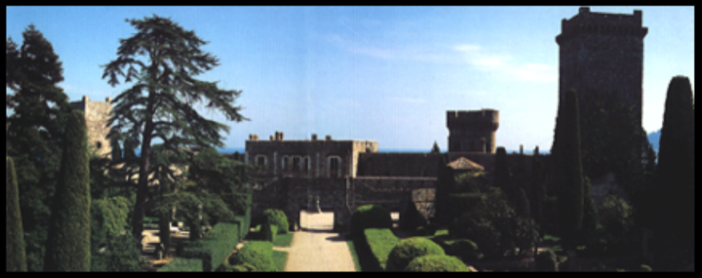
It became clear to me prior to travel that certain images would be necessary to complete the preconceived visions of several sections. The paintings by Clews had not been published to my knowledge, and were pertinent to the fulfillment of my idea for the Painter section. Special care was taken to capture these images on film and video. Numerous images of The God of Humormystics were also taken for use in the Sculptor section.
The original storyboard for the opening credits shot, which traveled out the window of the Château and across the ocean, had to be re-configured once in France. I had not remembered the close proximity of the marina, which blocked the view of the open ocean outside the Château. A tilting shot across the floor and up to the window inside Clews' bedroom provided an excellent departure from the castle but the exterior shot had to be created from the shore beside the west tower. From this view it became possible to create a flying motion by zooming out of the windows of the tower, sweeping down across the crashing waves, and zooming in as the camera neared the horizon line of the ocean. After numerous attempts to avoid sailboats, swimmers, and helicopters I managed to capture three segments of footage that would later be edited into what seemed to be one continuous sweeping motion.
The beauty and artistic detail of the castle provided the suggestion for numerous unanticipated possibilities. I became fascinated with the hardware and ironwork throughout the castle as well as the intricately carved doorways. These seemed to demand attention and led to major contributions in the Castelan section and the gallery entrance into the Whistling Doves performance space. The main room of the Château, one of the remaining structures of the original design of the castle, was most representative of the chivalric nature I often associated with Clews' fairy-tale world. This room contained a large marble table, the same one at which I had enjoyed daily meals in 1991. This table provided an excellent platform for dance, elevating the dance to appear against the arches of the gothic ceiling. Enamored by the atmosphere of this space, many hours were spent improvising movement phrases with cameras set at different locations around the room. I found this footage to be so striking that I later added the Chevalier section to showcase these efforts. This footage would make it possible to include the first inspiring score by Friesen, which had earlier been discarded from the audio selections. The pleasant surprise of this footage would result in one of my favorite sections.
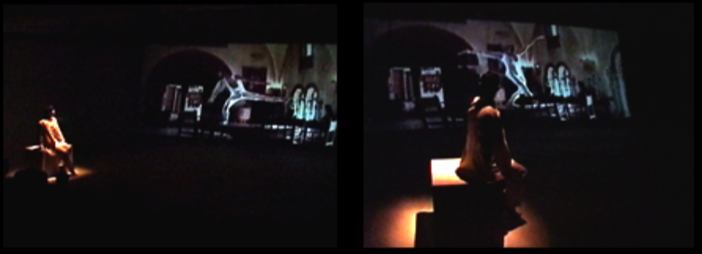
The technical issues involved in my project took a drastic shift once arriving in La Napoule. I was no longer dealing directly with computer technology but began focusing on other technical issues, which resulted from a lack of production tools and the configuration of electrical circuitry. I anticipated the change in electrical outlets bringing with me an adapter for use in recharging camera batteries. Since I was only able to bring with me a few small instruments and extension cords, it became an interesting challenge to see just how much could be achieved through the use of natural lighting and the accent lights that illuminated the castle at night. I studied the effects of sunlight on various areas of the Château and planned my video shoots accordingly. The main room, which became the primary setting for the Chevalier section was magically lit in the afternoons as sunlight came through the ocean-side windows. Outdoor lighting was used to accent the architectural majesty of the castle against the dark rippling ocean. A series of archways along the ocean were especially interesting to me and provided an existing reference to the Hallway of Infinity that had been artificially created through the use of technology. Many of these exterior lights were on timers, requiring the video shoots be scheduled during times in which these lights were in operation. On many occasions the lights would go off unexpectedly during the recording of a video segment. Most lights were turned off at eleven in the evening limiting the amount of time between dusk and darkness.
The lack of theatrical lighting instruments also became a problem when attempting to document the paintings of Clews that hung throughout the Château. The use of natural sunlight normally resulted in a dreadful glare. A great deal of time was spent altering the wooden shudders within the room to find the appropriate bounce of light onto each painting. One gallery was extremely dark making it unfeasible to video or photograph Clews' paintings.
One of the most challenging aspects of this process of media collection abroad was the fact that I had to work as a one-man crew. This became especially limiting during the capturing of video footage. I would have to frame the shot, focus the camera, and then move into the selected space to become the performer. This process eliminated any possibility of camera movement. This limitation could later be partly overcome through the use of motion setting in the Adobe Premiere software program used for digital video editing. A couple of shots were designed which required the movement of a door or window. A single shot which traveled out the window of a tower and down toward the tomb required that I open a window and simultaneously zoom and tilt the camera. This clip became a part of the Castelan section.
Several uninvited guests made special appearances during my video process. Many of these could not have been better planned and contributed greatly to the nature of my work. One evening when shooting a series of movement ideas underneath the archways, which lined the shore, a young man walked into the view of the camera and stopped dead in his tracks when realizing that I was performing in front of a video camera positioned off in the distance. Due to chance lighting his image appeared only as a shadow in the video. This clip was included in Castelan to foreshadow the spirit lurking under the arches in the Élan Vital section.
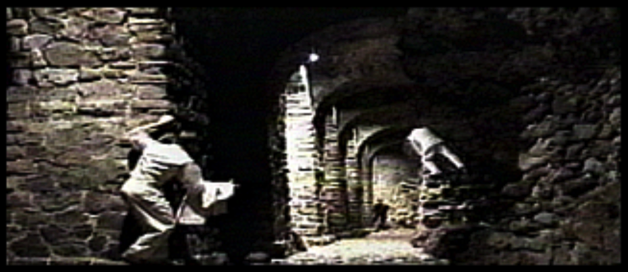
During a tracking shot that spiraled up the staircase of a dark tower in the castle, I discovered two white feathers dancing in the breeze illuminated by a beam of sunlight. I was amazed at how the delicate plumage drifted and swirled among the curved stairs. Feathers had always been a part of my original vision, yet these seemed to be destined for inclusion in the opening credits.
The most amazing and eerie anonymous performer was an old man who appeared from the darkness and walked toward me down the length of the sidewalk underneath the series of archways. As I was capturing the light rippling on the water through the long echoing architecture, the reflection on the water seemed to ascend from the ocean and bounce ever closer in my direction. As I continued to video this strange phenomenon I realized that it was, rather, a flashlight in the hand of an elderly gentleman taking a stroll by the sea. As I recognized the necessity for immediate response I quickly adjusted my focus onto his feet and continued to capture the image of his walking directly toward me. After tracking his footsteps for a good twenty seconds, I removed my eyes from the viewfinder of the camera to discover that the gentleman had disappeared. It was instantly clear that this was an inevitable shot made possible by being in the right place at the right time.
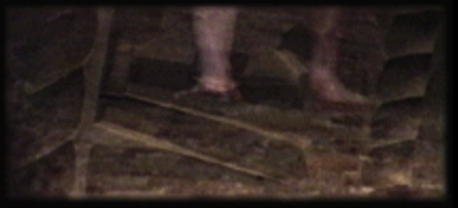
A magical effect was discovered during the late hours of my final evening in La Napoule. During a final attempt to make use of the exterior accent lights which illuminated the castle at night, I discovered that one lamp which provided light for the east tower was positioned in such a way that I could stand on a mound of rocks and my shadow would be enlarged and cast onto the tower in the distance. By positioning the camera near, and sometimes in the ocean, I was able to capture my image in the foreground with my dancing shadow on the tower in the background. This visually striking image seemed to be appreciated by the nearby ocean-side diners, who at the end of the shoot gave a round of applause. I left La Napoule in complete satisfaction with the materials I had been able to obtain for the completion of sections based on prior research and memory. I also took with me an exciting collection of new ideas and images to feed a lifetime of creative work. My next task would be to re-evaluate the master plan for Whistling Doves and find ways of interweaving selections from the new experiences encountered from my stay in La Napoule, a visit that will reside in my memory forever.
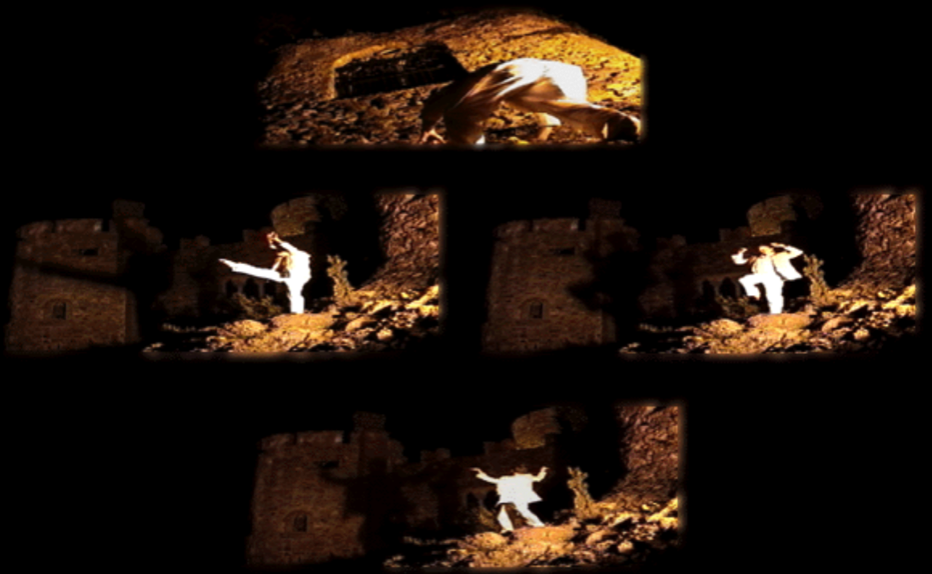
Following my on-site research at the Château de La Napoule my initial efforts were centered around developing and organizing slides, cataloguing video footage, and planning and selecting images which could be included within the outline of Whistling Doves. For the first time in the project I felt that I had, at my fingertips, all the media and information needed to complete the new work. With this came both a sense of relief and apprehension. I knew that it was time to make many of the important decisions I had often postponed due to lack of resources. I began with the obvious sections that were solidly developed in my mind while simultaneously toying with methods of using excerpts from the newly acquired materials.
The opening credits were developed as a series of symbols that hinted at the subject matter to be more fully explored in the sections that followed. I hoped to set the mood and location of Whistling Doves through glimpses of related images. Included in this collage were images of the castle's architecture, the moon, the key, Clews' sculptures, the dove, the feathers, the old man walking, the ocean, and the engraving above the main entrance to the castle, which reads, "Once Upon a Time."

The Painter section was completed to include ten of Clews' paintings, which in the end became an animated gallery of interacting images. The appearance of these images throughout this section provided a background for live interaction making use of the artist's palette and the addition of color to several paintings.

The original plan for Bon Vivant was completed with the use of images representing members of the Riviera Society. A beginning and ending was added to this section in a bookend fashion. The opening included footage of the dove hatching from an egg and maturing while the final image made use of the pair of doves captured on video in the garden of the Château. Previous musical selections for this section had included a song by Edith Piaf containing English lyrics, which spoke of being alone in her room while guests waltzed in the ballroom below. These lyrics were suggestive of Clews distancing himself from society, yet I found it difficult to justify the use of the female voice. This selection was discarded in hopes of creating a similar feeling by combining a popular French version and a symphonic version of the waltz, Parlez-Moi D'Amour.
The title for the Slicelight section comes from a line of poetry that I wrote during my first visit to the Château. The verse warns, "Fear not, for it is only the Slicelight which crawls across your bed at night" (Glenn). This reference to the moonlight traveling across the beds of guests in the castle was a dominant image for Whistling Doves from the beginning. This primarily atmospheric section that makes use of ocean footage and the moon and clouds as they appeared over the Château during my visit in 1998, deals with the inner thoughts and experiences of Clews. The gentle splashing of water on the rocks, which accompanied this footage, would be layered over this section's Shostakovich score. The choice in placement of the video of the castle's reflection in the dark water was made in hopes of creating a reflecting effect on the floor of the performance space. This solo voyage through the night involves a moon-shaped prop, which acts as partner and projection screen as it travels through the space. I hoped to transform the white-box into a three-dimensional ocean in which the rocking motions of the moon-shaped prop might be framed. Risk and struggle are blended with the ease of swinging and rocking on this kinetic prop. A suspended rope allowed for moments of suspension above the projected ocean and facilitated balances, which relied on the combination of supports from the prop and rope. The most intricately planned elements of video projection occurred in the Slicelight section. In order to identify the specific locations of the moving prop with which the projections could be coordinated, many tests were conducted within the space. The prop was placed in position, an image was projected into the space from the predetermined angle, and the coordinates of the reflected surface were mapped. From these calculations animations were carefully placed within the projected video.
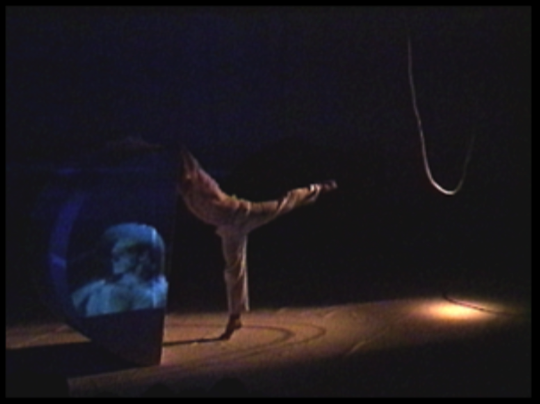
Following through with my initial intent to include text within the project, I designed a collage of spoken verses that drew from several poetic sources. With the main purpose of establishing the character of the solo performer in Whistling Doves, I was very selective of the content and knew that the movement needed to be very minimal in order not to distract the audience's ability to comprehend the spoken words. After recording my voice, numerous digital effects were applied in SoundEdit 16 to make the voice unrecognizable. Similar techniques in sound manipulation were used for text overlaid in other sections producing an ominous voice, which at times may have been perceived as the narrator, and at times as the voice of Clews himself. The presentation of Clews' character was paralleled within this section by the revealing of the mirror from behind the slowly opening curtains. Video footage of this action was projected on the two screens providing the first spatial illusion, that there were curtains on three walls. This foreshadowed the use of mirror projections that would occur later in the piece.
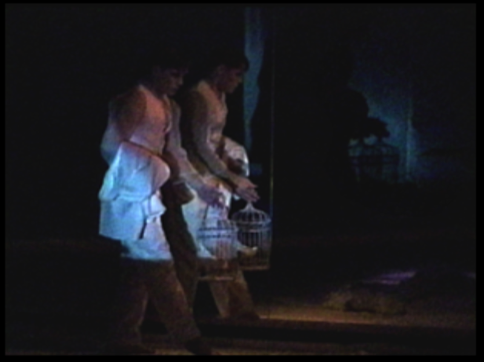
The decision was made to insert the Chevalier section to provide a context for much of the unanticipated footage collected in France. Friesen's score, First Ride, provided an energized counterpart to the collection of dynamic visuals. This music seemed to embody the romantic and noble world, which Clews created for himself within the walls of his castle. This sense permeated my performance in much of the footage used in this section. Chevalier provided the opportunity to represent Clews' fairy-tale image of life in direct contrast to the reality seen moments before in the Character section.
One unexpected effect that occurred as a result of camera movement, spatial design, and editing techniques was the implied journey down the elaborate staircase of the castle. The symmetrical projection of a traveling shot down the ironwork and marble steps of Clews' staircase resulted in the feeling of a spatial pull into the corner which then became the singular image one might experience when descending the staircase. With the accidental discovery of this effect I may use variations on this effect for future creations.
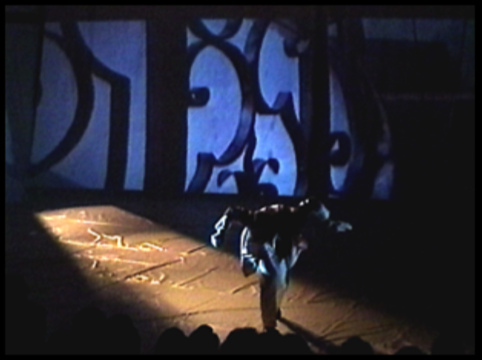
Knowing that I would need a break near the middle of Whistling Doves for a costume change, but not wanting to include an intermission or a break within the piece, I planned from the start to use an edited projection of my group dance, Henry's Own Words (1994), to temporarily hold the attention of the audience. I held on to this idea until very late in the process. During the second showing for my project committee it became more and more evident that this dance seemed out of place in the context of the whole. I accepted the challenge of developing a totally new, eight-minute section only weeks before the premiere. With the idea of exploring different areas of the castle through a journey behind many of the doors that had demanded my attention, I began the process of developing the Castelan section. The title was taken from Clews' epitaph that reads, "Castelan of La Mancha." After numerous inquiries on the definition of castelan I chose to go with Clews' spelling of the word although all research suggested the spelling, "castellan." I felt this title would work well to suggest that Clews might guide this tour as the man of the castle. This section allowed for the inclusion of the only full image of the castle as seen from a distance as well as panoramic views of the artist's studio and garden. I now realize that this section is a further investigation of an earlier experiment with Amiga technology using the FantaVision program. In 1994 my first interactive work was entitled House of Clews. This project consisted of an exploratory tour into different areas of the Château.
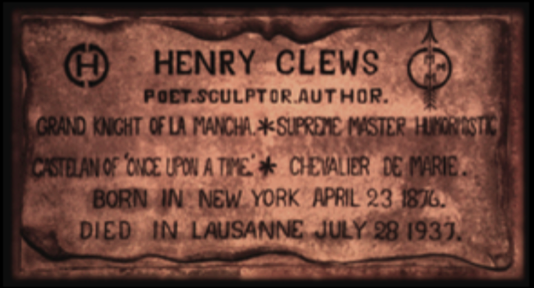
Upon viewing the tapes from France I realized I had accidentally left the camera running during my final walk through of the castle. This rough footage of pacing, pausing, looking, and turning would be included in Castelan in its raw form. This excerpt was reminiscent of a trapped spirit wandering the halls of the castle and seemed appropriate although I accepted the risk that this was in contrast to the more polished camera techniques used throughout the remainder of the work.
The white floor in the performance space was utilized as a projection screen during various parts of this section. I had not explored this option in previous sections and hoped that this added dimension would maintain intrigue while the live performer was absent from the space. Text was also included as projections floating within the rippling ocean on the floor. After months of clinging to the idea of using Henry's Own Words as an intermediate section of Whistling Doves, I removed all but the final image, which could hardly be recognized, superimposed within the ocean on the floor as if being reflected through a horizontal mirror, trapped within some other dimension.
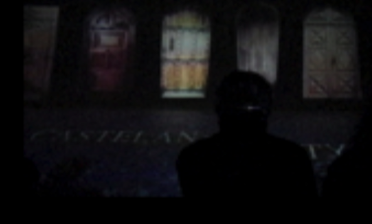
As I neared the final stages of video development I began looking toward the master plan for synchronizing all the sub-sections that would play in exact time from two S-VHS videocassette recorders. The video editing station at which I conducted most of my video work contains what is called a Targa Player. This program was designed to output numerous QuickTime movies in a specified sequence without delays between each. It was my plan to simply load the ten movie segments to be played from one video player and create a master tape that would coordinate frame-by-frame with the partnering master video. Through experiments it was discovered that the Targa Player was unable to manage the memory and duration of a fifty-minute sequence of quick-time movies. At this point I began searching for alternative methods of synchronizing my master videos.
A first attempt at traditional analog editing on the Panasonic S-VHS decks at the Denny Hall Multimedia Lab resulted in less than acceptable results. A visit to the Lord Hall Video Services office brought me face to face with another dead end. Their equipment and staff fees were far beyond the grasp of my budget. A third attempt brought me to the AVID Media Suite Pro station in the Hopkins Hall Emerging Technologies Studio. With only a short time before the premiere of Whistling Doves I was faced with the challenge of learning the capabilities of the AVID program. After a few hours of determined tutorial work I knew I had found the solution to my dilemma.
Other deadlines for promotional materials were also at hand. Accepting the challenge to maintain command over the numerous aspects of producing this project I set out to create the designs for a poster, postcards, tickets, and business cards. Adobe Photoshop was used for the majority of the graphic manipulations making use of materials gathered from video, photographs, and slides. Adobe PageMaker became an important contributor in the ability to coordinate graphics with text. I decided to use both color posters and color program covers. The ability to use color printing required more creative planning in order to keep the expense within my budget.
Chapter 3: Production
Defining a production period within the process of creating Whistling Doves is not an easy task. From the beginning, the constant development of production elements became necessary, a process which never ceased to exist although the focus may have shifted throughout the project. The nature of projected video combined with live performance requires a great deal of pre-planning and often demands early development and commitment to the elements which are to be included in the production. Due to the amount of editing time needed for video production, sets, props, costumes, and the performance environment had to be completed seven months prior to the premiere. With these elements completed I was able to shift my attention to an intense period of video production. Free of the normal last minute concerns in producing a work, it became possible to focus on other technical concerns, which could only be dealt with in the final performance setting. In order to achieve smooth runs throughout the premiere weekend much time and energy was spent in an attempt to design production aspects in a manner which would be self-sufficient. The production design of Whistling Doves came from the mind of a single individual who would, during performance, step into the world that had been created and release control of this vision. I knew that time with a production crew would be very limited so I attempted to minimize technical demands during performance.
The discovery of Columbus' ReArt, a recycling theatrical warehouse, opened up many possibilities for Whistling Doves. With an annual membership fee of thirty-five dollars patrons are allowed to take or borrow anything in the warehouse for use in the arts. Shortly after visiting ReArt and being intrigued by many of the items found there, I cleared my living room to act as storage space for the project. Over the following weeks I acquired numerous rolls of white canvas wallpaper, a truckload of mirrors, the moon-shaped prop which would be used in the Slicelight section, the large cube which would become the base of sculptures in the Sculpture section, and many other future dance props. I renamed my living room "ReArt East."
With the intention of producing a three-dimensional projection space I began work on a set design that would result in transforming Studio III into a white-box performance space. Working from a graduate student's budget I hoped to do this as inexpensively as possible. Using the canvas wallpaper acquired from ReArt I constructed thirteen screens that would hang, ceiling to floor, on two sides of the room. After shopping for inexpensive fabric, lightweight curtains were constructed to cover the wall of mirrors using rolls of white, banquet roll plastic. Three large black screens made of the same material were needed in back of the white screens to block the sunlight from the Studio III windows. A white spandex casing was made to cover the rope, which was suspended from the beams above. The most expensive element necessary to complete the space was a twenty-five by thirty-five foot vinyl floor covering. This tarp was ordered from a Milwaukee, WI company, which specializes in floor coverings for the Winter Guard International activity.
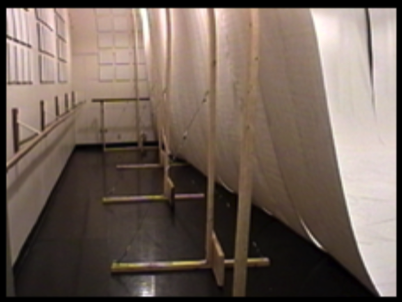
The props used in the Painter section, an enlarged paintbrush and palette, had to be designed and constructed. The outline for the palette was taken from a photograph, enlarged, and cut from a quarter-inch piece of plywood. The handle of a garden shovel would match the scale and become the brush to accompany this palette. The bristles of the brush would be a collection of hand-glued feathers. A birdcage resembling those seen in photographs of Clews was purchased at JoAnn Fabrics and Crafts. This cage, painted white, would be seen in live performance, in projected video, and on the poster for Whistling Doves. Other props included the large geometric shapes acquired at ReArt, which were also painted white.

After studying costume design and construction with Professor Dennis Parker from The Ohio State University's Department of Theatre, I set the challenge of creating the burial robe for Clews that would also act as his costume for transformation into a dove/spirit. A tour through the costume collection in the Department of Theatre revealed a flowing kimono, which would influence my design choices in this costume. Within one costume I hoped to suggest nobility, spiritual transformation, and birdlike characteristics. The silhouette of the dove was taken into consideration in this design and lead to the inclusion of a train of tail feathers. The design of the lapel was influenced by the removal of feathers from the chest area by the female dove allowing the transfer of heat during incubation.

A white, 1920's and 1930's period suit was borrowed and later purchased from the Department of Theatre's costume storage. This would provide the primary costume for the first half. When reentering the space for the second half of the performance I chose to wear the Henry's Own Words costume I had designed five years earlier. This unitard design with one flowing sleeve and a grid-like, abstract gauntlet maintained a medieval feel yet suggested a moving away from human attire and mortal existence.
My efforts in costume design and construction became a bit more relevant when discovering through my research that Clews had also maintained an interest in costumes. Fourriques explains:
The ability to make the burial robe slide across the floor and ascend into the air without the assistance of crewmembers required some thought. The automated screen, which moved up and down in front of the mirror, was to be the kinetic source for this effect. It was not possible to attach the costume to this screen from the start, as the screen moved upward following the opening credits. I had to devise a method of personally attaching the costume to the screen while in view of the audience. This was achieved by the use of fishing line and small rings which fit over the bar at the bottom of the screen. The ring for the on-stage side of the costume was hidden under the sleeve. My movement prior to the costume's ascent resolved just above the sleeve. In this position I was able to sneak the ring out and place it over the bar only seconds before the costume would rise off the floor. The opposite ring required the assistance of the audience member seated nearest the screen who was instructed as to when and how this was to be done.
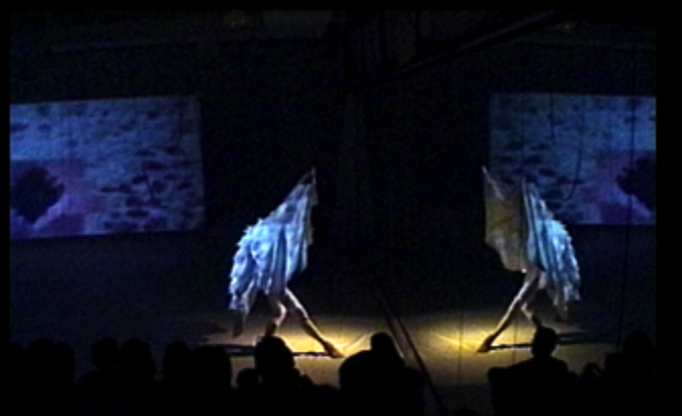
Another production element, which required testing and planning, was the effect of feathers falling from above. Through a series of Internet searches and email inquiries I received a donation of fifty pounds of white feathers from the Pacific Coast Feather Company. These were to add to the visual and dynamic climax of Whistling Doves during the Sprite section. Six box fans were positioned above the performance space. These were attached to self-constructed dimmer switches, which controlled the amount of air circulation created. By slowly increasing the rotation of the fans the pre-set feathers would begin to trickle down from above. This effect was enhanced by the projection of falling feathers on the walls of the space.
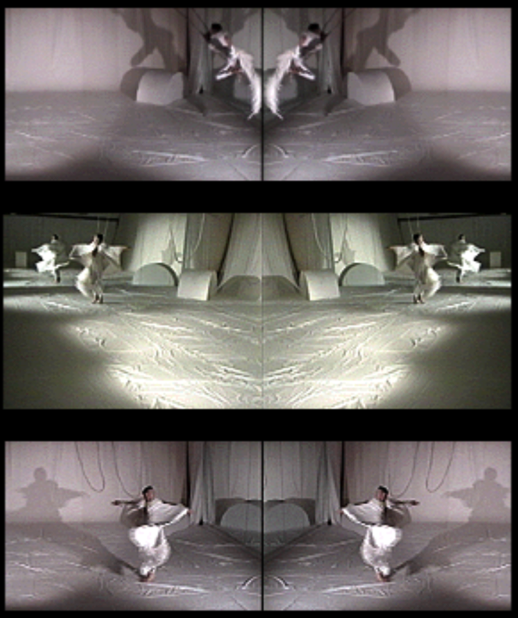
The technical process of creating the sound score for Whistling Doves involved the use of two sound editing programs. Audio tracks were digitized and sequenced using the audio capabilities of the Adobe Premiere software. Intermediate steps, which involved the application of filtering effects, required the use of SoundEdit 16. Audio compositions were created for each section prior to video editing. These sound scores became the timeline reference for planning video edits. At several times during the process audio compact disks were created for use in rehearsal. A similar process resulted in a composite of French music from the 1920's and 1930's which was used as house music prior to performance.
The final master videos used in Whistling Doves were the result of several phases of production. Original footage was captured on Hi-8 format. Selections from these original sources were digitized, edited, and mastered as Targa compressed QuickTime movies forming the twenty subsections of Whistling Doves. These digitized versions were often saved on CD-ROM or JAZ cartridges. All segments were also exported to S-VHS and often backed up on Hi-8 tapes as well. During the final composite making process, the S-VHS masters of these subsections were recaptured in digital form through the AVID Media Suite Pro. Once sequenced in the AVID program final master videos were created once again using the S-VHS format. This final stage of production required the most precise planning of the project. It was intended that two separate videocassette recorders would play synchronized tapes for a fifty-minute duration without phasing. The beginnings and endings of each segment had to match precisely to the second and frame. After hours of calculating the in and out points of each unit the resulting master tapes were within seven frames of perfect synchronization. That equals about one quarter of one second. If the two videocassette recorders used in performance played at the same speed there should be no recognizable problems between videos.
The use of theatrical lighting within a white space containing multiple video projections presents a very unique situation. Lighting Designer, Associate Professor David Covey, worked diligently with this problem. Lighting angles and levels were established taking into constant consideration the ability to see the projected video. The design relied heavily on down light and backlight. Specials focused on specific areas of the stage were used although limited instrumentation often reduced the ability to use certain areas of the space. Much of the lighting was influenced by spatial pathways and staging related to the choreography, yet during tech week some areas of movement were modified due to lighting deficiencies.
The five-person technical crew for Whistling Doves consisted of Michael Thomas, Christine Chen, Ann Yee, JoAnna Norris, and Daryse Osborne. This crew was assisted and directed by Covey, John Bohuslawsky, and myself. The duties of these crewmembers were divided into video operator, sound operator, projector one, projector two, and projector two assistant. Because of the design of the performance space, each crewmember would be relatively confined to their area once the house opened. Michael Thomas and Christine Chen worked together to control the video and sound elements. Sound levels needed to be adjusted throughout the evening but more importantly, any variations in video synchronization needed to be detected and corrected with care. It became extremely important for these operators to know at what points during the performance they were able to pause the front or side videos in order to regain synchronization. On a good night, these most important individuals would merely press start and stop. The job descriptions for other members of the tech crew included responsibilities such as focusing projectors, operating the automated screen, controlling the dimmer switches which regulated the flow of falling feathers, running the follow spot, and opening and closing the curtains which concealed the wall of mirrors.
The entryway through the Sullivant Hall Gallery became an additional element in the Whistling Doves experience. In hopes of creating an atmosphere and mind-set for audience members entering the studio, the gallery became the prelude to the main event. Thirteen, three-foot by five-foot prints of the hand-carved doors from the Château were produced and hung as banners in the thirteen niches, which lined the walls of the hallway. These scroll-like banners were illuminated by twenty-six taper candles against a background of echoing chants from a Micus score. These candles, evenly spaced down the hallway, produced the effect of an infinity mirror as the rhythm of flames progressed into the distance. Mounds of feathers lined the shelves and trickled down onto the floor suggesting the atmosphere of a dovecote. The focal point of this entry was a subtly illuminated branch on which rested a number of live doves.
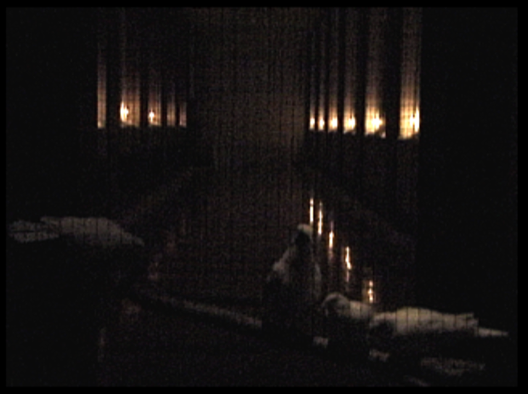
This gallery space was quickly transformed during performance to result in a totally different effect as the audience departed the performance space. Candles were removed and a strip of white canvas was unrolled on the floor down the length of the gallery. A single light source was positioned at the end of the gallery facing the individuals who were exiting. Audience members found it necessary to walk into the light as they departed. As they approached the exit they viewed the projection of a constant flow of doves, which appeared to fly past them down the length of the gallery. This experience was accompanied by the sounds of Cathedral Pines by Friesen.
Chapter 4: Creating Art in a Multimedia Theater of Motion: An Analysis and Critical Evaluation of Whistling Doves
The creation of Art must be the aspiration of artists working in a Multimedia Theater of Motion. Works that combine sources of media from different genres, including dance, are largely dependent on, and greatly influenced by, the creative process. The simultaneous development of related aspects of a multimedia work is crucial to achieving a cohesive effect and maintaining a sense of unity within the work of Art. It is through the process of creating Art that one discovers one's own sense of artistic values, develops a statement of artistic belief, and produces his/her artistic manifesto.
In the writings, which follow, I will expound my personal beliefs and experiences creating Art in the field of Multimedia Theater with specific reference to an analysis and critical evaluation of Whistling Doves. I will simultaneously illustrate my present method of working with multimedia and show how that method may evolve, mature, and develop through the process of further investigation.
In evaluating a work of Art one must first establish a value system from which to base aesthetic judgments. Immediately one faces the question, "Should Art be judged?" This issue may be debated indefinitely yet always returns to the fact that the experience of Art is specific to the line of communication which exists only between the creator and the one experiencing the Art. This process of communication begins with the choice making process in the mind of the artist. Multimedia artists must arrive at their own definition of Art. That which is considered Art in the multimedia theater should be defined by the same standards used to distinguish Art in any other field. The mere combination of artistic elements from a variety of genres does not constitute a work of Art. A "multimediaist" may communicate by borrowing from and collaging multiple languages. The multimedia artist, however, develops his/her own unique language, which is completely comprehensible, yet contains the influx of multiple dialects. This refinement that distinguishes the "multimediaist" from the multimedia artist became my goal in the development of Whistling Doves.
Former definitions of Art, many of which continue to stand true today, place emphasis on "beauty". Baumgarten has defined beauty as "a correspondence, i.e., an order of the parts in their mutual relations to each other and in their relation to the whole" (Tolstoy 25). It is this cohesive blending of elements in the multimedia theater which ultimately distinguishes the level of artistry at which a work may exist. A true work of Art is developed through the careful selection of materials that are included and result in communication set forth by the creator which needs no further explanation. If Art is considered "beauty", then according to Leo N. Tolstoy, "Beauty is something having an independent existence" (41). Although this is an age-old definition of beauty, and our late twentieth-century notion is quite different, I set out from the beginning to develop a work which would stand alone. Glimpses of this older vision of beauty seemed appropriate as Clews had a strong desire to reject modernization and cling to a more Romantic existence. An Artwork should require no apology or explanation and an audience upon leaving the theater should be affected on such a personal level that they are confident they have made a connection to the work. To support this experience program notes were used to provide additional information on Clews and the inspirations, which led to the creation of Whistling Doves. My goal of providing a pamphlet of information that audience members would retain as a memento of their experience seems to have been accomplished, as there was a minimal number of programs left behind or discarded.
The degree at which a work affects those who experience it is an important factor in determining value and in defining a work's ranking as Art. The response and participation of the audience is important to me as a creator. This line of communication motivates my process and influences many design choices along the way. The state of "aesthetic arrest" is my ultimate purpose in producing works, providing that moment at which elucidation occurs leaving the audience member reverently awestruck by the effect at hand. Artists who are able to give this experience to their audiences offer the primary element, which may not be found outside the live theater. On this subject Tolstoy has written:
Mary Wigman also has referred to this method of communication and has likened it to a fire which dances between two poles. Several audience members commented after witnessing the performance that they were deeply affected on an emotional level. This seemed especially true about the Slicelight section.
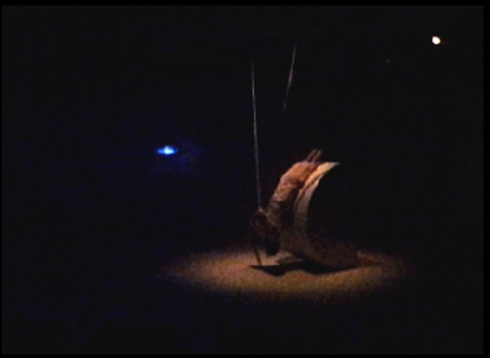
Since a major goal of my creating Art is the desire to communicate and affect an audience, one must look at the manner in which this may be achieved and also how answering this question may further define and categorize the work. The creation of Art for the purpose of communicating feeling or emotion will be considered. Susanne Langer has said:
Whistling Doves became the projection of a "felt" connection to Clews. As the form developed to represent this feeling a distinction became apparent. It became important to understand that feeling may be achieved in at least two different ways; feeling as an expression of emotion, and feeling through the expression of an abstract idea. One comment made by an observer stands out in my mind. She said, "Even if I did not fully understand it, I knew it was good because it was done so well." It would seem from this comment that a response was created based on craft and the manipulation of visual, kinetic, and auditory elements. Feeling resulted without complete understanding. This person's emotional response evolved through the observation of form, symbolization, and content.
Works, which do not deal in the realm of the heartfelt inner workings of the soul, may affect the audience through abstract means. Individuals often find the intricate, internal mechanisms of a finely tuned machine to be fascinating, with their synchronized interweavings of cause and effect. This skilled crafting of space, time, and motion may captivate viewers by its ingenious manipulation of form and design. When a non-emotional stimulus triggers the creative process of a theater work spectators may find themselves completely intrigued by craftsmanship which makes use of abstraction and symbolization, effecting an emotional response from a non-emotional stimulus. In this case emotions may be found through the associations made in the minds of the audience members. This has been my primary approach to creating in the past. Through Whistling Doves I was able to bring these prior experiences into my process while blending them with subject matter, which was often emotionally driven. Firmly believing that Art must go beyond a flow of emotion, presenting this content in an abstract manner became of concern.
One aim in creating Whistling Doves was to bring the art works of Clews to the attention of a broader audience. I hoped to perpetuate his art through presenting samples of his work along with glimpses of his personal experience in an original and abstract manner. I would say that I was successful in this endeavor, as I only encountered a couple of individuals throughout my process who had heard of Clews. The four audiences of approximately seventy people each left the performance having witnessed many images related to Clews. I chose to use symbolization such as the key, the moon, and the mirror to provide indirect insight into Clews' world. The metaphor of the dove, which developed in congruency with the experiences of Clews, provided a means for abstraction. Although the work was based in reality, I did not attempt to realistically present his life or art. Content extracted from research on Clews commented on these matters through the form of a new and independent work.
A work that "stands alone," self contained and cohesive in nature, may never be reproduced without all its contributing elements. This means that every aspect is crucial to the collective effect. Inversely, no single element may fully represent the whole of such an experience. This ephemeral nature of live performance produces the most rare form of Art, which must be cherished and appreciated for the brief moment of its existence. During the months that led to the premiere of Whistling Doves, I made numerous choices as I aspired to create a work which will be perceived as "standing alone" and having the quality of "beauty". My selective combination of elements in hopes of creating a pleasing experience for the spectators dealt mainly with the interrelationship of live performance, video projections, audio, reflections, props, sets, and costumes. The performance space became my three-dimensional canvas on which I demonstrated my present investigations in creating Art as a multimedia artist.
A valuable aspect of planning Whistling Doves, which may benefit future site-specific works, was the spatial mapping employed in the use of video projection. This involved a series of testing and re-testing throughout the entire process. Once the videos were designed for use in the space it became imperative that projector, prop, and screen placement be precisely recreated. These challenges in detail, consistency, and patience required additional time during set up before each showing and performance. Non-traditional uses of technology contributed to the process of spatial mapping. I had a vision and found it necessary to discover a method of using technology to bring this vision to fruition.
The process of creating a work of Art in the field of multimedia brings to the forefront a series of concerns, which must be addressed by the artist. Questions related to constructed form, the synthesis of media elements, and focus/multi-focus issues are among the many considerations one may encounter. In the creation of a new work of Art, one which surpasses the mere layering of individual elements and stands above the existence of its solitary ingredients, in short, multimedia artists must define the craft of this art form based on the specific concerns which are unique to this method, drawing on multiple sources of media to construct Art.
Collective effect is born through the interdependency of media and through the enfolding of design influences encountered through working in this manner. Openness to intuitive choices and unexpected influences throughout the process must be embraced. This "listening" allows the work to evolve and bring itself to life. It is increasingly important for the artist working in this form of additive composition to welcome the creative suggestions emerging from the blending of various media. Space may suggest light, sound may suggest space, props may suggest movement, projections-space, movement-sound, and so on. A work may surely face defeat if its creator insists on clinging to an idea and refuses to allow it to be modified or partnered by other elements of the production.
The ability to maintain an objective view of my work was often difficult due to personal attachment and total engagement. Distancing myself from the work and feedback from outside eyes was made possible through a series of preliminary showings. Three such showings for my project committee provided an opportunity not only for my advisors to witness progress, but for myself as well. These progressive showings provided reality checks from which I was able to track my timeline and evaluate that which could be attained in the time remaining prior to the premiere. The early showings were a bit frustrating as I had little means of visualizing the final product, which, at the time was relatively clear in my mind. It became evident early in the process that the movement aspect would slowly evolve along with other elements and receive detailed attention only in the final stages of development. Experiments with video synchronization during these showings made it very clear that this would become a crucial element in the success of the work. Issues of focus and excessive visual stimulation became apparent. Comments regarding the need to do less moving assisted in my ability to contribute to the overall effect without constantly being the primary element within the space. This understanding of the sharing of responsibility between production elements would be recognized as characteristic of most work in the area of multimedia.
The most significant contribution, which resulted from the showings, was the development of the Castelan section. This replacement for the Henry's Own Words projection occurred following the final showing after agreeing with comments that the Henry's Own Words video seemed out of place. This late addition linked the images from the gallery entrance to the main event and allowed for the exploration of an additional dimension of projection, usage of the floor as a reflective surface. This section provided another suggestion for the character of Clews, the spirit that continues to exist inside the castle. Castelan, along with other sections, seems to have provided a comprehensive view of the many aspects of Clews' life. Making the decision to release the idea of Henry's Own Words and to develop a new, eight-minute section at such a late time in my process taught me a great deal. Had I continued to force the issue, the overall work would have suffered. It seemed to be a risk at the time, but now I can look back to see that this was unquestionably the right choice.
Questions as to what should be included, the method of inclusion, and a list of other logistical concerns are also the responsibility of the creator. It is important to determine which artistic elements are imperative in getting to the essence of the message. Langer says, "Art is craftsmanship, but to a special end: the creation of expressive forms—visually, audibly, or even imaginatively perceivable forms that set forth the nature of human feeling" (111). Decisions and manipulations as related to the elements of design, which relate to all fusible media, are the craft for artistic expression in the multimedia theater, as in all other art forms. Marshall Cohen refers to this by quoting Langer, "The feeling in a work of art is something the artist conceived as he created the symbolic form to present it" (Cohen 30). Spurred by an intense emotional experience, I faced the challenge of developing a form in which to present my message. The development of this form directly influenced the feelings set forth in the final product. This process was marked by selectively limiting content while also allowing for the development of ideas not previously determined. Sculpting the flow of feeling was as influential in the development of form as other visual and dynamic issues.
The opportunity to interview Murray Louis on his recollections of the Château and Clews' art added additional insight to my research. His comments seemed to validate my 1991 experience at the home of Clews while encouraging me to pursue my own creative manner of expressing this experience through dance and the use of multimedia. Louis' comments reminded me that I had the freedom to develop a form for this new work that would be unique to my beliefs as an artist and my encounter with Clews. My process seemed to be coming full circle, as Louis had witnessed my original exposure to Clews seven years earlier. I was amazed at how vividly Louis remembered my fascination with Clews. Hearing his words reminded me how intense this original experience had been and empowered me to continue my investigation and creative work. Louis, full of creative ideas as always, offered the suggestion of including the symbol of a dove's head that dissolves into the silhouette of Clews. He was unaware that I had previously experimented with this image, which was to appear on the traveling prop in the Slicelight section. This hardly subtle metamorphosis assisted in the suggestion of Clews' alter ego, the dove.
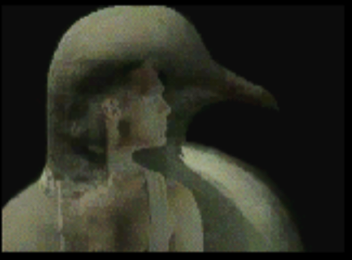
The evolutionary process, which occurs when creating for the multimedia theater, requires total integration and flexibility. The inclusion of symbols to suggest relationships may greatly affect the process. Nelson Goodman has said, "a symbol may select from and organize its universe and be itself in turn informed or transformed" (92). Observing and identifying the communicative potential of these transformations is a key element in this craft. As the form of a work unfolds one will experience a sense of cohesion if the creator has been alert to the natural suggestions, which at times may only be heard as a whisper in his intuitive mind.
Langer defines artistic form as, "a perceptual unity of something seen, heard, or imagined—that is, the configuration, or Gestalt, of an experience" (165). This creating of form in which to present an imaginative vision has been an obstacle for artists throughout history. The selective choices made for materials to be included within a work will not only greatly influence the work itself but may result in the classification of the work by those who experience it. Jack Anderson refers to this by saying:
I have found that this richness, whether Langer's "Gestalt", Tolstoy's "Spiritual Union", Baumgarten's "Beauty", or anyone else's definition of Art, becomes a terribly complex matter when blending the strengths of various media in an attempt to create one unified product. It became my challenge to avoid the chaos, which I have often experienced in multimedia, by taking a close look at the inter-relationship of the elements of design which, as in all art forms, were to be a part of Whistling Doves.
It was through the creation of Whistling Doves that these issues of creating Art for a multimedia theater became even more clear to me. In answering the question concerning what should or should not be included and how these elements should be intertwined, the issue of focus constantly came into the forefront of my attention. The creation of unity seemed to rest partly on the ability to combine visual media in a way that did not create visual conflict, or visual overload. This method of conducting focus did not, however, exclude the possibility of multi-focus. I found that by varying the use of space through lighting and projections I was able to create a wide range of contrast, at times clearing the palette to simply focus on one element. At other times I filled the space with several elements creating multi-focus, which brought the space to life with excitement. As the form of this work evolved I became fascinated by the manner in which each idea presented the foundation on which other design choices might be based. It is by working in this manner that I find myself intrigued to create works for the multimedia theater. Finding the true connections and deep interrelationships of media may provide at least one lifetime of inspiration toward the understanding of my own personal journey as related to the creation of Art.
The twenty-first century artist, more than any generation of artists before him, may selectively combine influences by drawing on the wealth of historical knowledge and examples of Art created through multiple genres. The placing of value on specific approaches to Art and the further exploration of a person's unique combination of these influences may develop and define, or redefine, Art as related to that artist. My work in producing Whistling Doves may be recognized as a display of what I, as an artist, value in creating. This work has also allowed for experimentation and discovery and has had an impact on my future creative endeavors and artistic development. It has been through this process that I now acknowledge the filtration of influences from previous approaches to creating and may more clearly recognize my standing as a modernist working in a post-modern world.
Predictions as to the development of new art forms through the influences and developments of cutting edge technology have been made throughout history. One such foresight, which seems to be in direct relation to the area of theater that I find most interesting, was made by Oskar Schlemmer (1888-1943). "Among the emblems of our time are the new potentials of technology and invention which we can use to create altogether new hypotheses and which can thus engender, or at least give promise of, the boldest fantasies" (Gropius 17). Many similarities in approach may be found between my works and the works of Schlemmer and Alwin Nikolais. Jack Anderson described the work of Nikolais by saying, "He sought a polygamy of motion, shape, color, and sound. Whatever one called him, he was a creator of multimedia form that made dazzling use of theatrical illusion." (Anderson, Art 203) I think that if these artists were producing works today they might find comparable uses of technology. As I further explore this area of total theater I acknowledge the influences of these artists. Illusions and the creation of atmospheres are of specific interest to me. The application of video technology allows for exploration beyond these artists' use of theatrical lighting, phosphorescence, and slide projection. The potential for moving projections allowed for the establishment of a variety of settings within Whistling Doves.
The influences that define a personal style of working in the arts are certainly results, in part, of the age in which the artist lives and their personal exposure to previously created works and approaches to the creative process. It is possible, however, for a creator to be inspired and guided from internal motivations and instinctual perception, which may not easily be attributed to specific, landmark influences in life. As related to dance, style may be defined as "The signature of an individual - the composite of personal and artistic preferences that characterizes the mode, manner, and content of one's choreography - theories of movement, an identified theory or model that uses one basic phenomenon as the source and propelling force for movement - movement patterns that embody the attitudes and values of a given age or culture" (Blom 136, 137). In understanding one's own process it is important for an artist to acknowledge these tendencies and identify the direction that one is inclined to explore. It is through the unrestricted commitment to that direction of motivated action that the artist will be brought face to face with his/her unique and redefining contribution to the world of Art.
Great care was taken in the early conceptualization of Whistling Doves to include personal challenges that demanded exploration in new areas of dance and multimedia. These personal demands led to an accumulation of experience and appreciation in many areas of artistic creation. These included: solo performance, costume design and construction, set design, sound engineering, and numerous techniques in video editing and simple animations. The desire to ground this work in historical fact brought with it the need to further develop skills in field research. This wide range of obstacles provided an excellent atmosphere for personal growth and self-development.
Along this journey of self-discovery in the field of multimedia I have found myself fascinated, as had other artists such as Schlemmer and Nikolais who created using the technologies of different decades, by the potentials of altered perception and illusion through the use of late twentieth century technology. The performance space may be instantly altered through the use of lights and projections. Isolated spaces may be created, an entire space may be illuminated, or a change in location may be represented through video or slide projection. A panoramic view was achieved through multiple projections in Whistling Doves. Illusions of shifting time can be created as well as the manipulations, which may occur in relation to perceived movement. In the Sprite section of Whistling Doves multiple images were projected of the dancer traveling in curvilinear, sweeping motions. The live performer dances in unison with these images creating the effect of real-time video projection. Ten images of the movement phrases were seen simultaneously through the combination of video projections and mirror reflections. Thus, the solo concert produced an ensemble effect that resulted in the feeling of group performance. At times a disorienting effect occurred which blurred the perception of reflections and shadows.
Following the residency John T. Meyer said:
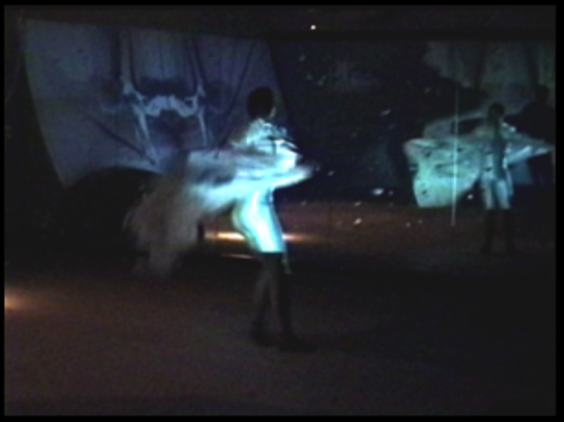
Anderson described the work of Nikolais, which might just as well describe Whistling Doves, by saying that Nikolais' work will, "blur distinctions between illusion and reality and make it difficult for spectators to determine which shapes before them were real and which were shadows or slide projections" (203).
I have to admit placing a great deal of value on the visual elements within my work. I have always enjoyed the things that captivated my attention and maintained my curiosity based on their visual design, especially those in motion. Schlemmer reveals a similar delight when stating, "We are primarily visually oriented beings and can therefore take pleasure in the purely optical; we can manipulate forms and discover mysterious and surprising effects in mechanical motion from concealed sources; we can convert and transfigure space through form, color, and light." Later he describes these effects as, "a feast for the eyes" (88). Whistling Doves was certainly this, a variety of visual effects densely packaged within one evening of multimedia dance theater.
After years of viewing torturous dance works, which forced me to actively motivate myself to pay attention, I have accepted the fact that a significant role of my dance based works is to intrigue my audience and to maintain its effortless attention. It is my hope that audience members find some element of the production curious and interesting and that they, at no point, find within themselves a need for self-discipline. This effect is made possible through the many ways in which technology may alter performance space, allude to shifts in time, and transform location. The range of these possibilities allows for creating variety and contrast, essential ingredients for maintaining the interest of today's fast paced society. Historical references suggest that this in not a new way of captivating an audience. Anderson refers to this when he says, "In recent years, a form of multimedia choreographic theatre has developed.....in many ways they resemble the balletic spectacles of a century ago. In fact, they may be today's equivalents of those spectacles. Our own spectacles hold the attention of theatregoers fond of mixed media. In every case, they do so because they present many kinds of movement and visual images.....recent spectacles can be equally varied in their contents (Anderson, Choreography 235–237). Although Anderson is referring to the extravaganzas of the late nineteenth-century, I have often thought of Whistling Doves as a modern adaptation from the Romantic ballet. The life, which Clews lived within the walls of his castle in France, provides an ideal story line comparable to that of the great ballets. Future developments of this work may lead to a larger scale production with numerous dancers. One section envisioned for Whistling Doves, which included a number of Clews' sculptures coming to life was not realized due to the choice of retaining a solo work. These sculptures were somewhat animated through computer-assisted technology, yet not embodied in live dance.
A work such as this, which borrows from the arts of painting, sculpture, writing, music, theatre, and dance becomes difficult to classify. This labeling becomes increasingly difficult when realized through a computer-assisted production process. The accumulation of media elements from various art forms into one work of Art may confuse audience members who desire an orderly classification of performance types.
One must not assume that all multimedia works follow the traditions of the postmodernists who often juxtaposed non-related materials creating the effect of pastiche and the sense of a world superficially saturated with images. We must not also presuppose that in giving audiences "much to think about," we are not able to give them these things in an ordered and crafted manner that will not overload their perceptual abilities.
Elizabeth Hayes, in her book, Dance Composition and Production, says:
I would not necessarily describe my method of working with multimedia in a manner that associates words such as "unrelated" or "unexpected" to juxtaposition. I presently see my process as more of an extension of the total theater. I have found myself positioned, through my recent work in multimedia theater as a modernist existing in a post-modern world. It has been through these recent experiments that I have been able to identify that which is uniquely specific to my areas of interest.
Two relevant aspects of my work, the architectural relationships of media elements and the role of movement performance, bring my work into the realm of a Multimedia Theater of Motion. Havelock Ellis makes reference to the relationship between these aspects.
Even though, according to Ellis, dance came first I do not place a greater value on dance than on architecture within my works. I hope, in fact, that the two will find unity within each work that is created. The elements of architecture, rhythm, line, form, texture, and space directly relate to the actual performance space, and to any props used, as well as to the movement produced by the human body. Visual rhythm and the manipulation of space provide many possibilities for creating interest and contrast within a production. The shape element in movement is constantly seen in relation to these architectural elements and this shape awareness, when combined with constant presence in time, space and most importantly energy dynamics, produces the virtuoso dancer.
The role of movement within my creations for the theater leans toward a modernist point of view and is directly related to the German tradition in Modern Dance through the teachings of Alwin Nikolais. I strongly depend on the movement aspect of a work to clearly and purely communicate dynamic and kinetic ideas that qualitatively transcend the movement of everyday life. It is this surpassing of reality which delivers the dancer and the affiliated observers from mere movement into the experience of Motion. Mary Wigman says:
The qualitative spectrum, which a dancer may draw on to perform a range of dynamic vocabulary, is largely dependent on the inner motivations that drive his/her performance. This expressive process of conducting energy is often fed by imagery and results in the necessary transcendence of a performer into a new consciousness, far beyond the sensations of common kinesthetics. "In short, the dance, like every other artistic expression, presupposes a heightened, increased life response. Moreover, the heightened response does not always have to have a happy background. There is something alive in every individual which makes him capable of giving outward manifestation (through the medium of bodily movement) to his feelings, or rather, to that which inwardly stirs him" (Cohen 305).
This line of energy from the dancer is often expected to extend beyond the physical body and into the many props used in performance. Bringing these props to life and giving them an existence of their own demands a great deal of training on the part of the dancer. It is critical that the props not appear as being simply manipulated by the performer. A connection or union must be achieved between these two, a partnership. Within the Slicelight section of Whistling Doves a large, white, moon-shaped, prop serves as partner, set, symbol, and projection screen. The relevance of this prop within the solo becomes evident through the rapid succession of roles it plays. It is this type of integration that I hope to explore further in the future in order to find more integrated connections between form and content. We may witness similar concepts in the works of Nikolais. George Beiswanger pointed out that Nikolais, "wants things to move, to be seen, and to be heard, and he wants the resulting aliveness of things to be apparent even when the things are dancers. Hence the props dance and the dancers prop (not that they do not dance as well)" (Anderson, Art 204).
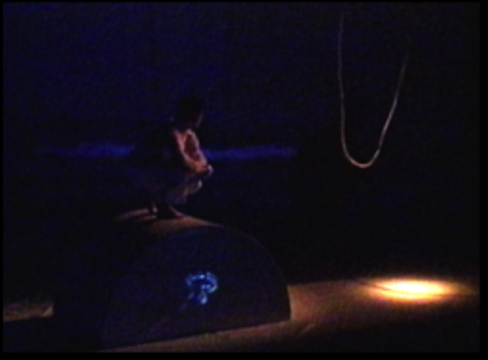
In developing an approach to multimedia theater which brings me to the vitality of expression I most need in life, I tend to draw from the influences and inspirations of my past. The creation of Whistling Doves is an example of this process that continues to evolve. I have found that the producing of Art does not rest solely on the product, yet may be reflected in the process, one, which in the case of Whistling Doves has fueled my existence for the past months. Clews and I may have lived a world apart in space and time yet we unquestionably share a common existence. The key element that we share is an immeasurable love for our art. Clews once said, "It does not matter what you love but you must love something with all your heart and soul." Through the creation of Whistling Doves I have been allowed insight into Clews' experience, a lifetime of discipline, isolation, and inspiration. The driving motivation which has lead to the premiere of this evening of multimedia dance theater may be best described in the words of Clews, "When work stops, life stops, creation stops."

Bibliography
Anderson, Jack. Art Without Boundaries. Iowa City: University of Iowa Press, 1997.
Anderson, Jack. Choreography Observed. Iowa City: University of Iowa Press, 1987.
American and French Modern Masters. New York: Wildenstein, 1955.
This exhibition catalogue records a May 1955 benefit exhibition for the La Napoule Art Foundation held at Wildenstein in New York City. The sixty-one paintings created by American and French artists included works by Chagall, Matisse, Picasso, and many others. Included is a listing of the board of trustees and various sponsors.
Bantock, Nick. The Forgetting Room. New York: HarperCollins Publishers, 1997.
Best, David. Expression in Movement and the Arts. London: Lepus Books, 1974.
Blom, Lynn Anne and L. Tarin Chaplin. The Intimate Act of Choreography. Pittsburgh: University of Pittsburgh Press, 1992.
Chambers, Arthur. Our Life After Death. Philadelphia: George W. Jacobs & Co., 1902.
"Chateau As Memorial: Widow of Clews, the Sculptor, Opens His French Home." New York Times 30 July 1939: 31.
Cohen, Marshall and Roger Copeland. What is Dance? New York: Oxford University Press, 1983.
Clews, Henry. Mumbo Jumbo. New York: Boni and Liveright Publishers, 1923.
Clews, Mancha Madison and Margaret. Once Upon a Time at La Napoule: The Memoirs of Marie Clews. Beverly Massachusetts: Memoirs Unlimited, Inc., 1998.
This paperback represents the most complete resource available on the personal experiences of Henry Clew, Jr. and his wife Marie. Family histories are traced to include the meeting of this couple, their early lives together in Paris, and their relocation to the Château de La Napoule. Specific information is given on Clews' publication, Mumbo Jumbo, as well as his dedicated life as an artist. The book is well illustrated including photographs of Henry Clews' children and grandchildren.
Clews, Margaret. Letter to the author. 5 January 1999.
Covey, Liz and Rosemary Ingham. The Costume Designer's Handbook. Portsmouth, NH: Rosemary Ingham and Liz Covey, 1992.
Covey, Liz and Rosemary Ingham. The Costume Technician's Handbook. Portsmouth, NH: Heinemann Educational Books, Inc., 1992.
Foundation Henry Clews, La Napoule. 17 Aquarillistes Americains Contemporains. Paris: Les Presses Artistiques, [1954?].
Fourriques, Nelcy. Personal interview. 8 September 1998.
"George Blumenthal Weds Mrs. Clews." New York Times 19 Dec. 1935: 30.
Glenn, Tim. Untitled poem. La Napoule, France: n.p., 1991.
"Gods, Ogs, Wogs: Castle of Weird Images Becomes a Museum." Life 15 Oct. 1951: 119–24.
This article announces the opening of the castle of Henry Clews, Jr. as a museum. It contains a brief history of Clews and the castle as well as a description of the Château. An emphasis is placed on the eerie, weird, and grotesque tone of the artist's work and is illustrated with samples of the range of artistic styles as well as inside looks at the castle.
Goodman, Nelson. Languages of Art. Indianapolis: Hacket Publishing Company, 1976.
Gropius, Walter and Arthur S. Wensinger. The Theater of the Bauhaus. Baltimore: John Hopkins University press, 1961.
Hayes, Elizabeth R. Dance Composition and Production. Princeton, NJ: Princeton Book Company, 1993.
Hudson, Thomas Jay. The Evolution of the Soul. Chicago: A.C. McClurg & Co., 1904.
Huxley, Michael and Noel Witts. The Twentieth-Century Performance Reader. New York: Routledge, 1996.
Langer, Susanne K. Problems of Art. New York: Charles Scribner's Sons, 1957.
Lanoux, Armand. Paris in the Twenties. New York: Golden Griffin Books, 1960.
"Leta Clews Wed to S. L. Cromwell." New York Times 2 May 1936: 12.
Louis, Murray. Personal interview. 2 September 1998.
"Louise Clews's Troth Reported from Nice." New York Times 26 Aug. 1930: 25.
"Low and High Comedy as a Criticism of Life." Rev. of Mumbo Jumbo, by Henry Clews, Jr. New York Times 22 April 1923: 8.
This positive book review of "Mumbo Jumbo" by Henry Clews, Jr. introduces his statement about the troubles with modern society through quotes from the book's introduction. It includes a complete synopsis of the play, Mumbo Jumbo, as well as a photo of the author.
Maheu-Viennot, Isabelle. Artistes a La Napoule: La Napoule Art Foundation. Amboise: Editions du Cygne, 1993.
McManus, Irene. Dreamscapes: The Art of Juan González. New York: Hudson Hills Press, 1994.
Metropolitan Museum of Art. Exhibition of Sculpture by Henry Clews, Jr. New York: Marchbanks Press, 1939.
Meyer, John. Personal interview. 25 July 1998.
"Mrs. Morris Clews, Belle of '90's, Dies." New York Times 29 Oct. 1936: 25.
"Mrs. Simpson Guest at Riviera Dance." New York Times 13 Feb. 1937: 15.
This article gives a description of the social events surrounding a 1937 dinner hosted by Henry Clews, Jr. in a Cannes, France restaurant. The guest of honor, Mrs. Wallis Simpson, the woman for whom Edward VIII abdicated the throne of Great Britain, was among the many prestigious guests.
Museum, Albert and Victoria. Four Hundred Years of Fashion. London: William Collins Sons & Company Ltd., 1984.
"Museum to Show Americans' Work." New York Times 8 May 1939: 20.
"Never Never Land." Time 31 July 1939: v.34, 32.
"Notes from New York." Apollo August 1939: 72–73.
Peacock, John. Men's Fashion: The Complete Sourcebook. London: Thames and Hudson Ltd., 1996.
Proske, Beatrice Gilman. Henry Clews, Jr. Sculptor. Brookgreen, SC: Printed by the order of the Trustees [Brookgreen Gardens], 1953.
This detailed account of the sculptures of Henry Clews, Jr. includes both a brief family history and a history of the castle. It traces artistic style, influences, creative stages, and critical responses as well as describes the castle's ornamental design and analyzes many of Clews' works (especially "The Thinker"). It includes a personal description of Henry by art critic, Pierre Borel, and a copy of the poem engraved on Clews' tomb. Its illustrations include various sculptures, the castle, and a portrait of Clews.
"Riviera 'Repatriates'." The Evening Bulletin. 29 Oct. 1945:12.
Tierney, Tom. Great Fashion Designs of the Thirties. New York: Dover Publishers, 1984.
Tierney, Tom. Great Fashion Designs of the Twenties. New York: Dover Publishers, 1983.
Tolstoy, Leo N. What is Art? New York: Macmillan Publishing Company. 1960.
Wigman, Mary. The Language of Dance. Middletown, CT: Wesleyan University Press. 1966.